Ronald.phillips
Shared posts
Dying Light: Definitive Edition Tomorrow
Intel Arc A730M High-End Mobility GPU Still Slower Than RTX 3060M Despite Latest Drivers, Reviews Show Lackluster Gaming Performance

The first performance review of Intel's Arc A730M GPU using the official drivers that support the mobility GPU have been published and it looks like the gaming performance still isn't that good.
Intel Arc A730M GPU Disappoints: Loses To RTX 3060M Despite Using Latest Drivers
Yesterday, we got to see the first performance results of the Intel Arc A730M Mobility GPU within gaming benchmarks however, the first showcase was very poor since the high-end Alchemist GPU was barely faster than an NVIDIA RTX 3050. We couldn't get the exact details of how the graphics performance was measured and whether DTT was disabled or not but soon after the benchmarks popped up, Intel silently released a new driver which specifically added support for the Intel Arc A730M GPU.
The driver version '30.0.101.1735' was a rerelease of the previous version and the only thing that had been added was support for the Intel Arc A730M GPU which is now available in the Asian PC market with brands such as Machenike offering their DAWN gaming laptop. So it is likely that the performance will be impacted slightly when running the chip on the latest drivers.
Intel Arc A730M GPU Specs:
The Intel Arc A730M is equipped with an ACM-G10 GPU but houses 24 Xe Cores (3072 ALUs), 24 ray tracing units, a graphics clock of 1100 MHz, 12 GB GDDR6 memory running across a 192-bit bus interface, and a TDP target of 80-120W. This GPU will aim for the GeForce RTX 3060 series mobility options.
Intel Arc A-Series Mobility GPU Lineup:
| Graphics Card Variant | GPU Variant | GPU Die | Execution Units | Shading Units (Cores) | Memory Capacity | Memory Speed | Memory Bus | TGP |
|---|---|---|---|---|---|---|---|---|
| Arc A770M | Xe-HPG 512EU | Arc ACM-G10 | 512 EUs | 4096 | 16 GB GDDR6 | 16 Gbps | 256-bit | 120-150W |
| Arc A730M | Xe-HPG 384EU | Arc ACM-G10 | 384 EUs | 3072 | 12 GB GDDR6 | 14 Gbps | 192-bit | 80-120W |
| Arc A550M | Xe-HPG 256EU | Arc ACM-G10 | 256 EUs | 2048 | 8 GB GDDR6 | 14 Gbps | 128-bit | 60-80W |
| Arc A370M | Xe-HPG 128EU | Arc ACM-G11 | 128 EUs | 1024 | 4 GB GDDR6 | 14 Gbps | 64-bit | 35-50W |
| Arc A350M | Xe-HPG 96EU | Arc ACM-G11 | 96 EUs | 768 | 4 GB GDDR6 | 14 Gbps | 64-bit | 25-35W |
The new benchmarks were published by ITHome and a new performance video was also published by 'Golden Pig Upgrade' at Bilibili. Now ITHome is running their benchmarks on the unofficial driver with a version number '30.0.101.1726' while the Bilibili content creator is running his benchmarks on the latest '30.0.101.1735' drivers.
So one should expect the official drivers to perform better however as showcased within synthetic workloads, the performance is the same across the two drivers. But once again, that shouldn't necessarily be reflective of gaming performance since the games need to be optimized on a per-driver basis whereas synthetic benchmarks can make full use of the GPU despite the drivers being a mess (most of the time). And that's once again the case in the latest benchmarks.
Intel Arc A730M GPU vs NVIDIA RTX 3060M Gaming GPU Benchmarks:
| Golden Pig Upgrade | IT-Home | Golden Pig Upgrade | Golden Pig Upgrade & NotebookCheck |
|
|---|---|---|---|---|
| GPU | ARC A730M | ARC A730M | ARC A730M | GeForce RTX 3060M |
| Driver | 30.0.101.1369 | 30.0.101.1726 | 30.0.101.1735 | varies |
| 3DMark Time Spy | 10107 (invalid) | 10532 (valid) | 10202 (invalid) | 7981 (NB) |
| 3DMark Time Spy Extreme | – | 5049 (valid) | – | — |
| 3DMark Fire Strike | – | 23923 (?) | – | 20142 (NB) |
| 3DMark Fire Strike Extreme | – | 11061 (valid) | – | – |
| Assassin’s Creed: Odyssey (1440p/High) | 32 FPS | – | 33 FPS | – |
| CS:GO (1440p/High) | – | 183 FPS | – | – |
| CS:GO (1080p/Highest) | – | – | 135.15 FPS | 404.58 FPS (GP) |
| APEX Legends (1440p/?) | – | 103 FPS | – | 124 FPS (NB) |
| Elden Ring (1200p/High) | – | 76 FPS | – | 59.1 FPS (NB) |
| Control (1080p/?) | – | 72 FPS | – | 78.1 FPS (NB) |
| Cyberpunk (1200p/Medium) | – | 54 FPS | – | 91 FPS (NB) |
| F1 2020 (1080p/High) | 123 FPS | – | – | 159 FPS (NB) |
| Metro Exodus (1080p/High) | 70 FPS | – | 77.69 FPS | 72.89 FPS (GP) |
| Metro Exodus (1440p/High) | 55 FPS | – | – | – |
| Total War: Troy (High) | – | – | 114.5 FPS | 136.6 FPS (GP) |
| Boundary (1080p) | – | – | 20.7 PFS | 76.2 FPS (with DLSS) |
| Gears of War 5 (DX12) | – | – | 90.3 FPS | 133.4 FPS (GP) |
| Hitman 2 (DX12) | – | – | 76.11 FPS | 100.27 FPS (GP) |
| Civilization 6 (DX12) | – | 74.82 | 101.63 FPS (GP) | |
| Strange Brigade (Vulkan) | – | – | 188 FPS | 200 FPS (GP) |
You can note that the Intel Arc A730M once again fails to deliver graphics performance on par with the NVIDIA RTX 3060M in gaming benchmarks. While the Alchemist GPU is faster in 3DMark, it loses in almost every title whether at 1080p or 1440p. The Arc A730M GPU was also showcased earlier as running between 90-110W in this laptop configuration while the GeForce RTX 3060M is running at a 130W TGP so there's a slight TDP advantage on the NVIDIA card but still, the performance efficiency doesn't look that good.
Intel Arc A730M GPU Gaming Benchmarks:
Intel Arc A730M GPU Synthetic Benchmarks:
Now we know why the high-end lineup has once again been limited to Chinese markets first prior to their global release and the reason is simply that the software is hardly ready. Synthetics don't show the actual gaming performance and there's nothing good to talk about Arc GPUs even in that regard. This is a GPU based on a high-end chip that's barely competitive with NVIDIA's mainstream mobility GPU. If this ends up being the final performance when we reach global launch, then the only saving grace for Arc would be its pricing otherwise, well, it's all in front of you just how poor the performance is at the moment for Arc.
Intel's Arc A5 and A7 GPUs for the global market are expected to hit retail by Late Summer along with the desktop discrete graphics lineup so we can hope that Intel will have their drivers ready & in a more functional state by then.
The post Intel Arc A730M High-End Mobility GPU Still Slower Than RTX 3060M Despite Latest Drivers, Reviews Show Lackluster Gaming Performance by Hassan Mujtaba appeared first on Wccftech.
How to Decide Between a Gas and Charcoal Grill

Grilling can be intimidating. It tends to be fairly male-dominated, though I will say that BBQ dudes are much more chill, welcoming, and helpful than sous-vide dudes, who tend to be pedantic and slightly unhinged. But community aside, it can be hard to know where to get started. The first question you need to ask…
Director Steve McQueen's Movies Ranked Worst To Best
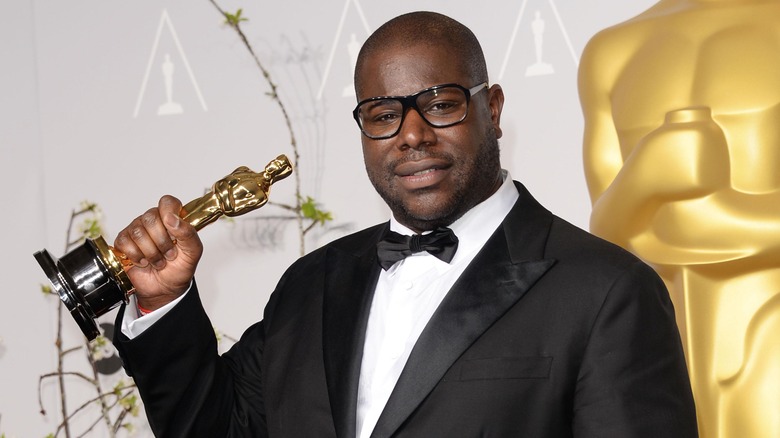
Steve McQueen isn't just a great filmmaker. He's an activist for greater representation within the industry. McQueen recently criticized the discriminatory practices in the British film system during the BAFTA awards. It is no secret that the history of Hollywood is intertwined with systemic discrimination. Artists of color have struggled to see themselves represented on screen since the earliest days of cinema. It is important to support diverse storytellers that offer insights on recent events.
Before he became a narrative filmmaker, McQueen experimented with various forms of visual art, including documentaries, short films, and portraits. He made his directorial debut in 2008 with the film, "Hunger." "Hunger" is based on the true story of the 1981 Irish prison hunger strike. It was the first of many projects that explored important moments in history and critical socio-political movements. McQueen has tackled such weighty topics as police brutality, slavery, sex addiction, political corruption, and sexism.
In addition to the four theatrical feature films that he has directed, McQueen also created the Amazon anthology miniseries "Small Axe." The series includes five different films set within London's West Indian communities during periods of social change. In the streaming era, the line between "film" and "television" is less distinct. Each entry in "Small Axe" is worth considering as a standalone feature film. The second installment, "Lovers Rock," was even the opening night presentation at the 2020 New York Film Festival.
Here are all of the films directed by Steve McQueen, ranked from worst to best.
Alex Wheatle
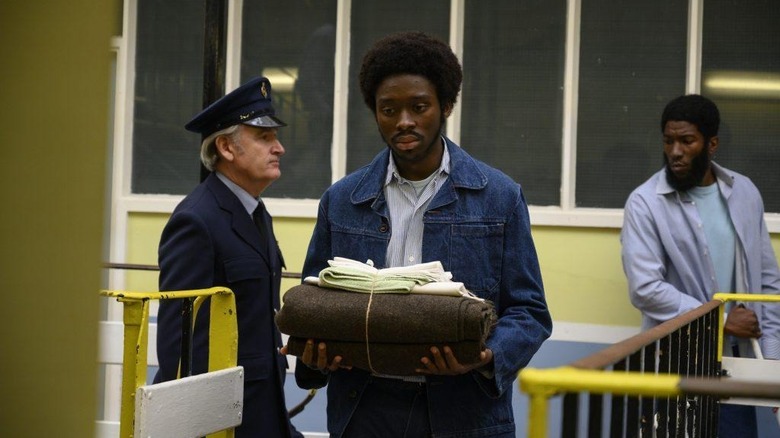
The fourth installment of "Small Axe" is easily the weakest of the series. While "Alex Wheatle" may tell an important story, it lacks the emotional depth and visual complexity of McQueen's best work. McQueen has a unique way of making history come to life. His films are so vivid that the historical figures are compelling as characters and are not overshadowed by their importance. "Alex Wheatle" is the only project in McQueen's filmography that feels like a stale retelling of history. While it speaks to critical issues, "Alex Wheatle" isn't as compelling on an emotional level.
The film follows the titular British novelist, Alex Wheatle (Sheyi Cole). Wheatle was raised in the slums of Brixton and took an early interest in poetry and writing. He was inspired by his diverse community to use his art to chronicle the changing political state. During the 1980s, Brixton's inhabitants openly resisted the brutality of the police. Wheatle was imprisoned in 1981 for his participation in the riots.
It's understandable why McQueen would relate to the story of someone who combines artistry and activism. Unfortunately, "Alex Wheatle" is so focused on the author's historical significance that it doesn't take the time to explore why his storytelling was such a sensation. At 66 minutes, it only includes a portion of Wheatle's life. Outside of his narrative films, McQueen has also created many docu-series projects. Perhaps "Alex Wheatle" would have worked better as a documentary and not a narrative feature.
Lovers Rock
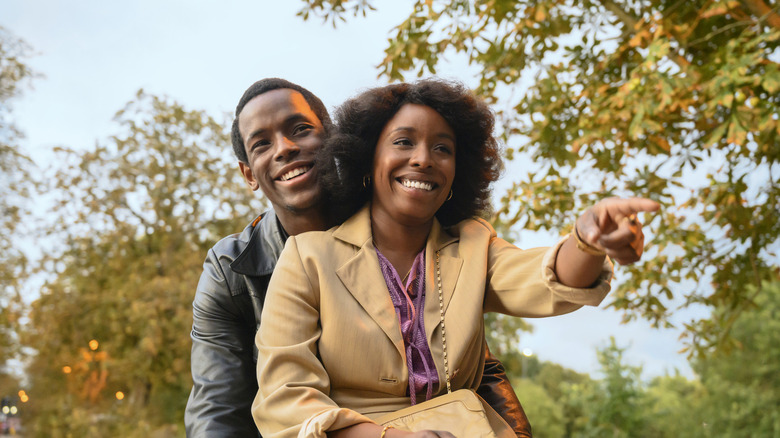
"Lovers Rock" explores new terrain for Steve McQueen. McQueen's projects generally focus on tragedy and suffering, but "Lovers Rock" is a purely delightful sensory experience. That doesn't mean that it is any less important than the rest of his work. The film celebrates Black love and romance. It is easily the most stylistically ambitious of McQueen's projects. The narrative is fluid and feels closer to a French New Wave film than a historical drama. It's almost shocking that a director known for his emotional intensity could create the perfect "hangout movie," but you can never doubt McQueen's dexterity with genre.
"Lovers Rock" takes place at a house party over the course of one night in West London during the 1980s. Essentially, the film just moves to the rhythm of the music. The incredible soundtrack includes songs from artists such as Blondie, Dennis Brown, Pat Kelly, King Tubby, The Revolutionaries, and Michael Gordon. "Lovers Rock" tells the simple story of how Franklyn Cooper (Micheal Ward) and Martha Trenton (Amarah-Jae St. Aubyn) fall in love. It doesn't take them long to form a deep spiritual connection.
McQueen doesn't cast judgment on the ways that the characters express themselves. He simply observes their culture. It's particularly enjoyable to watch, considering how emotionally grueling the rest of the films in the "Small Axe" series are. It's no discredit to "Lovers Rock" that it ranks this low on the list. It simply shows how impressive the films above it are.
Education
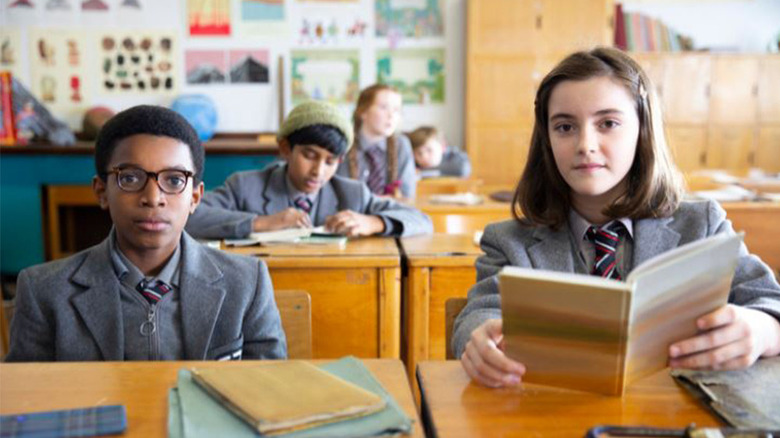
Steve McQueen hasn't just looked to history for inspiration. The final film in the "Small Axe" collection, "Education," was loosely based on his real life. "Education" is set in a small London community during the 1970s. Although the story is fictional, the events in "Education" are based on an actual civil rights issue that continues to affect students of color today. London courts came under fire by activists for an unofficial policy of moving Black students to different schools for the "educationally subnormal." As a result, there was a huge disparity in the quality of education, based on race.
The film primarily focuses on a West Indian activist group that calls attention to the practice. The heart of the film is the story of a young student named Kingsley (Kenyah Sandy). Kingsley is clearly gifted and talented. He dreams of becoming an astronaut, explorer, and scientist. However, Kingsley is deemed "disruptive" in class and sent to the headmaster's office for punishment. He is assigned to a "special needs" school, which doesn't take advantage of his potential. This is infuriating on both a historical and emotional level. McQueen doesn't just show how systematic oppression works. He shows the despair of a young boy who just wants to learn.
McQueen is able to explore a larger issue through an individualistic story. Sandy delivers a startlingly emotional performance for such a young actor. He is more restrained than most child performers are capable of being.
Widows
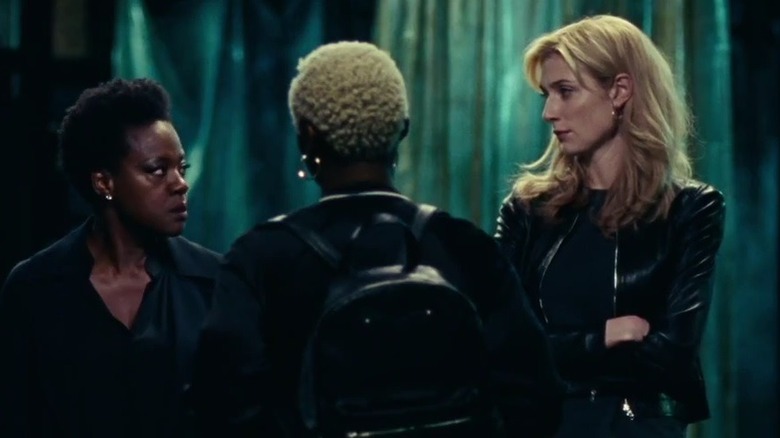
"Widows" is a much different type of project for Steve McQueen. McQueen had been strictly known as an "arthouse filmmaker," and he seemed like an odd choice to helm a star-studded genre film. However, "Widows" is much more complex than most heist movies. The film explores a variety of ongoing issues in modern-day Chicago, including gender disparity, police brutality, electioneering, political dynasties, economic disenfranchisement, and the treatment of sex workers. Written by "Gone Girl" author and screenwriter Gillian Flynn, the film was inspired by Lynda La Plante's crime series of the same name.
"Widows" is set in the aftermath of a heist gone wrong. The criminal leader Harry Rawlings (Liam Neeson) and his accomplices Florek (Jon Bernthal) and Carlos (Manuel Garcia-Rulfo) are killed after an attempted robbery. Harry's wife, Veronica (Viola Davis), is left devastated. She discovers that Harry left behind the plans for one last job. Veronica recruits Florek's widow Alice (Elizabeth Debicki), Carlos' widow Linda (Michelle Rodriguez), and the babysitter, Belle (Cynthia Erivo), to break into the home of power broker Tom Mulligan (Robert Duvall). Mulligan's son, Jack (Colin Farrell), is running for mayor against crime boss Jamal Manning (Brian Tyree Henry). Jamal's brother, Jatemme (Daniel Kaluuya), stalks Veronica's team.
"Widows" is so packed with characters that it almost seems like it's biting off more than it can chew. While not all of the storylines have the same depth, it's amazing to see what McQueen is capable of on a studio film.
Red, White, And Blue
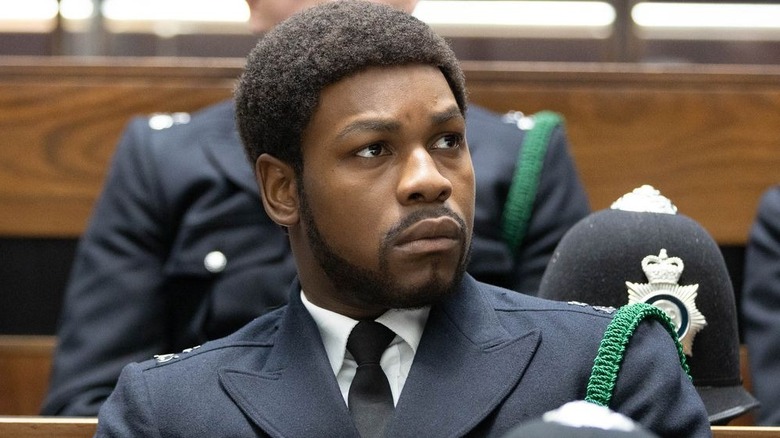
"Small Axe" was released on BBC and Prime Video at the end of 2020. Given everything that had transpired in that year, the series' themes felt more relevant than ever. None of the films in "Small Axe" captured the public outrage quite like the third installment, "Red, White, and Blue." The film explores the history of police brutality through the eyes of a Black officer. "Red, White, and Blue" is both an insightful and disturbing film to watch. It's important to understand how this system of oppression began, but it can be discouraging to see how little has changed.
"Red, White, and Blue" is set in the mid-1980s and follows the true story of Leroy Logan (John Boyega). Logan witnessed his father being brutalized by two police officers when he was young. While most boys his age learned to fear the police, Logan wants to change things from within. Logan goes through the training to join the London Metropolitan Police Force. Although he passes all of his necessary exams, Logan is still treated as a subordinate. Frustrated by the lack of progress, Logan creates the Black Police Association to push for reform.
"Red, White, and Blue" explores both the obvious and subtle ways in which racism rears its ugly head. Logan is offered unappealing assignments and is forced to watch his fellow officers commit acts of abuse. Boyega delivers the best performance of his career.
Shame
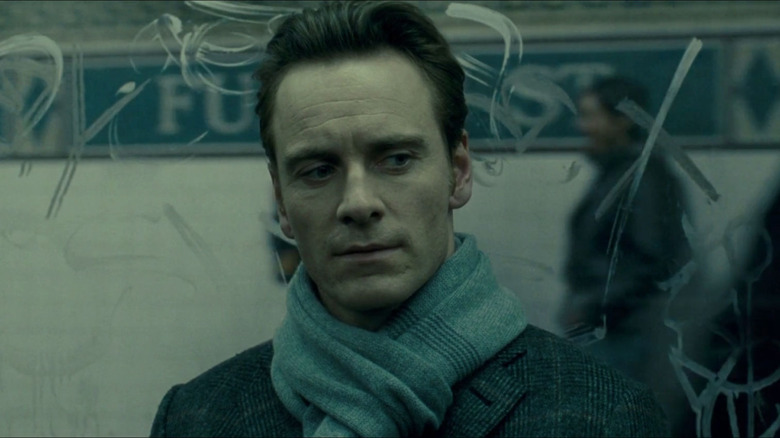
There is a stigma around sexual addiction, and it is understandable why filmmakers would be hesitant to tackle such a weighty topic. It would be easy for a film to feel disrespectful to actual victims if it dramatized their issues. Steve McQueen is incredibly brave to explore the topic head-on. His 2011 film, "Shame," is an unflinching look at loneliness, addiction, and trauma. It is one of the rare mainstream films to receive an NC-17 rating from the MPAA. NC-17 films are generally not as successful financially and aren't able to reach broad audiences. However, it would have seemed insincere for McQueen to tell this story without including all of the realistic details.
"Shame" follows financial executive Brandon Sullivan (Michael Fassbender), a sex addict living in New York City. Brandon hides his behavior from his friends and family. He secretly downloads pornographic content on his computer while he is at work and frequently hires prostitutes. Brandon follows a strict routine every day. However, his schedule is thrust into chaos when his sister, Sissy (Carey Mulligan), arrives in town. Sissy reminds Brandon of his tormented childhood. He has ignored his trauma for almost his entire life and is afraid to talk about it. Brandon struggles to connect with Sissy.
Fassbender's performance is emotionally meticulous. Brandon's behavior is often disturbing, but Fassbender shows how he is suffering. McQueen does not shy away from the shocking details and focuses on intense moments of silence.
Hunger
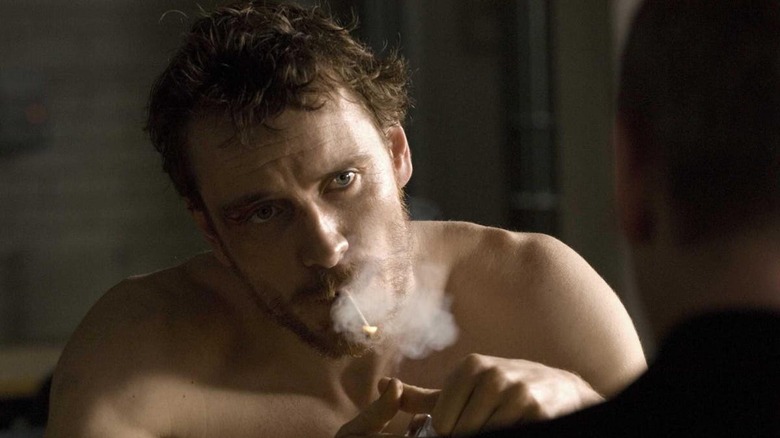
Steve McQueen's feature directorial debut announced how unafraid he was to deal with disturbing material. "Hunger" is not for the faint of heart, but for those that can stomach the violent content, it tells an important story about the history of abuse within the British prison system. "Hunger" also launched McQueen's partnership with Michael Fassbender. Fassbender became one of the best actors of his generation thanks to his breakout role in "Hunger."
"Hunger" takes place during the 1981 hunger strike in Northern Ireland. Convicted prisoners were not granted their ensured rights and subsequently started various protest movements. An attempted violent outburst is unsuccessful. Former Irish Republican Army officer Bobby Sands (Fassbender) unites the prisoners in their resistance efforts. Facing no other alternative, Bobby directs the prisoners to punish themselves, in order to make their demands heard. Bobby and the rest of his followers starve themselves for over two months. The guards refuse to do anything as the prisoners' bodies deteriorate. After 66 days of protest, Bobby dies of starvation.
Fassbender shows Bobby's desperation and determination. He only chooses to harm himself after his attempts to be heard are met with silence. It is absolutely devastating to watch Fassbender's body slowly fall apart. McQueen's methodical direction features many extended shots that last just long enough to be uncomfortable. The brief scenes featuring Bobby's parents (Des McAleer and Helen Madden) add an emotional context to his struggles. They are heartbroken to see their son in such a state.
Mangrove
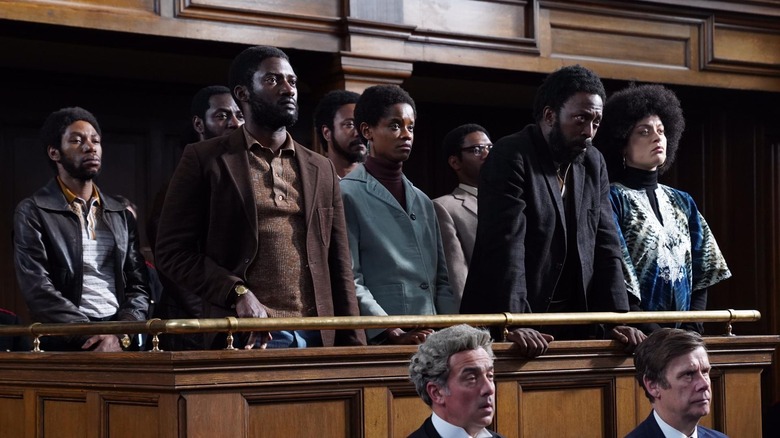
The first installment in the "Small Axe" anthology, "Mangrove," is one of the greatest courtroom dramas ever made. It spotlights one of the most important cases in London's history, which sadly has been forgotten by most historical accounts. "Mangrove" follows a group of Black activists, who are falsely accused of inciting violence at a Caribbean restaurant in Notting Hill. "The Mangrove Nine" are denied their guaranteed rights and subjected to skepticism from the British judicial system. Although the trial resulted in the nine men's acquittals, it came after Judge Edward Clarke (Alex Jennings) concluded that there was "evidence of racial hatred on both sides."
The ruling clearly didn't go far enough, but it marked the first time that the London police's crimes were highlighted in public. "Mangrove" sets the perfect tone for the "Small Axe" series and foreshadows the themes of the other films. "Mangrove" celebrates black culture like "Lovers Rock," explores police brutality like "Red, White, and Blue," and deconstructs tools of systematic discrimination like "Education." It's the longest film in the series. McQueen does not skimp on any of the legal terminology that mischaracterized the events.
If you want to see further proof of how unique and important McQueen's perspective is, just check out Aaron Sorkin's courtroom drama "The Trial of the Chicago 7," which debuted the same month as "Mangrove." Both films depict activists on trial for resisting police brutality, but "The Trial of the Chicago 7" barely acknowledges the Black Panther Party.
12 Years A Slave
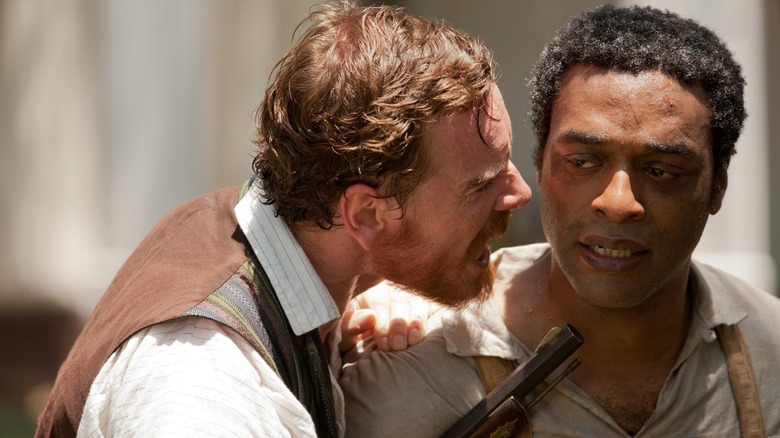
It's no discredit to the rest of Steve McQueen's work that the No. 1 selection is an obvious choice. "12 Years s Slave" isn't just McQueen's best film, but one of the greatest achievements in cinematic history. The Academy Award for best picture is rarely handed to an actual masterpiece. Although he was denied a best director win, McQueen can consider himself an Oscar winner thanks to his producing credit on the film. He is one of only six Black filmmakers ever nominated for best director.
It would be impossible for any single film to capture the entirety of Black Americans' experience as enslaved people. McQueen keeps the film focused on just one story. He adapted Solomon Northup's (Chiwetel Ejiofor) 1853 memoir of the same name. Northup was a free man who was offered a fake job as a musician by two slavers in Washington D.C. He was sold into slavery and remained in captivity for over a decade. McQueen shows Solomon's life as he is passed as property between different slave owners in the south.
McQueen focuses on the minutiae of Solomon's daily experience. He is forced to assimilate to survive. The cruelest of Solomon's tormentors, Edwin Epps, is played by McQueen's frequent collaborator Michael Fassbender. Fassbender delivers one of the most terrifying performances in film history. Epps prides himself on his ability to break the spirits of his slaves. "12 Years A Slave" is essential viewing for every American.
Read this next: Every Martin Scorsese Feature Ranked From Worst To Best
The post Director Steve McQueen's Movies Ranked Worst To Best appeared first on /Film.
Stranger Things Sound Effects Editor Angelo Palazzo On The Magic Of IKEA Furniture And Vegetables [Interview]
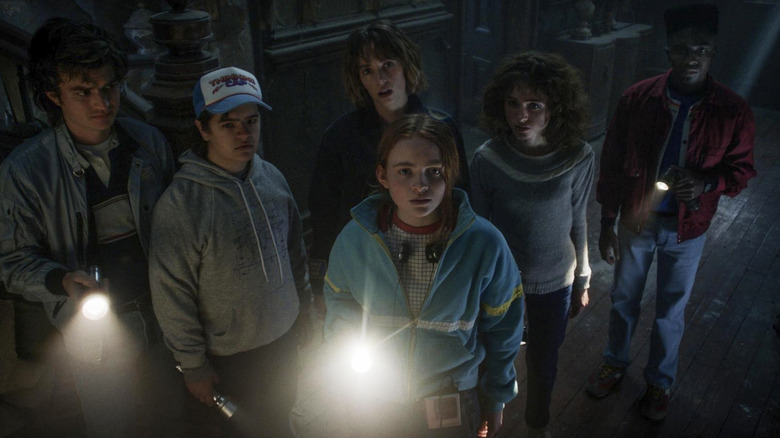
Lead sound effects editor Angelo Palazzo is sometimes left speechless by season 4 of "Stranger Things." Palazzo previously won an Emmy for his work on season 3, but for him, season 4 was a whole new different beast. Although he has over 25 years of experience in moviemaking, nothing quite compares to working on the Duffer Brothers' hit Netflix show.
As the series matures with its main audience, season 4 takes a darker turn. As a result, so do the sound effects. Palazzo went darker and harder with the "Stranger Things" soundscape. Monsters are more aggressive and the hits hurt more than before. The lead sound effects editor, who's also worked with Robert Rodriguez many times in the past, recently told us about his work on "Stranger Things" season 4, his longtime collaboration with sound designer Craig Henighan, and fond memories from his experience on "Grindhouse." Spoilers ahead for season 4, volume 1.
'I Went Ahead And Started Recording A Bunch Of Vegetables'
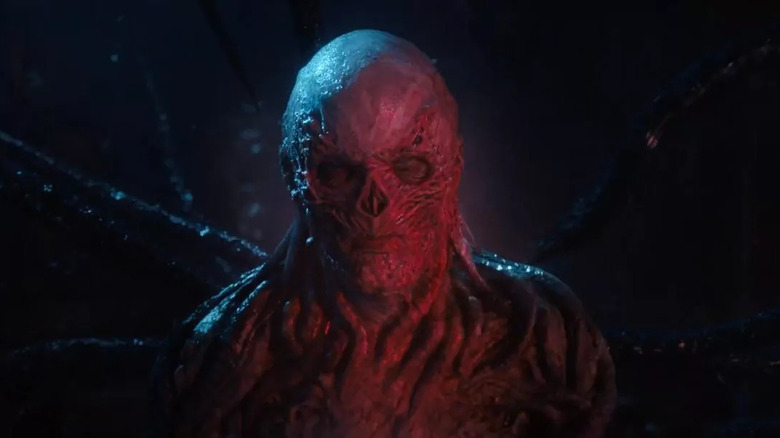
Did a lot of sound effects carry over from past seasons or did the change in tone alter a lot of the "Stranger Things" sound effects audiences know now?
So a lot of the stuff that did carry over was stuff that was initially established by Craig Henighan, the lead sound designer. Craig and I have worked together for over 15 years now. A lot of times he'll do design for something and then he'll go, "Can you take a shot at this?" He likes to kind of see where I go with it. And then we kind of exchange ideas.
With season 4, he was actually even jokingly saying, "Man, this is the fourth season. I'm kind of running out of ideas. Can you take a shot?" So what happened was I would take a lot of the foundational signature sounds that he built that everyone knows -- for The Upside Down, the Demogorgons, and the dogs came back too -- so I would get all that original material, and then I would kind of do the version 2.0 of that. I would take the source material and I would help to elevate it, make it more aggressive, because a lot of the whole season is leaning into the horror of it. There's a lot more violence. There's a lot more aggression. There's gore, maximum gore.
So the Demogorgons, I built a palette of much more aggressive attacking movements, more aggressive vocalizations, but it was all built off what we initially had there. It was a blast because anything goes. These things are such wild creatures. And then there was a whole salad of new things to design, too. But yeah, to answer your question, we definitely start with the foundational signature stuff, but it was very much like, "Do your thing, man. Go to the next level with all this, get more aggressive, get more gritty."
And then a newer character, a newer creature, was the bats, [which] was a big thing that came. I got into that back in October, they were sending me early scenes of this. Since it's like a mindhive, they're all interrelated, I knew I could hint at a bit of the Demogorgons with the vibe with the bats.
With the bats, they didn't want the typical just screechy sounds, you know? We were thinking about how do we make these things sound unique and organic, but also scary and foreign and terrifying? One of the things we came across, which is the f***ing weirdest thing that ended up working out great, was we tried typical things, pitching up lots of pig sounds and different things like that. [...] And then, what ended up working, I had this sliding closet door that's super squeaky. It has just the amount of screech and chittery sounds to it when you slide it. Craig also had a similar thing, so we ended up recording these sliding closet doors as the basis of these vocals. It just had the most aggressive quality to it that worked out awesome.
A lot of you may not know, but with sound design, a lot of the source material for creatures actually comes from real world things like that, wood bending and chittering wood, or screeching sounds, or scraping cardboard on cement, or dragging cinder blocks. Those are foundational sounds you can use for screaming. When you get cinder blocks on cement, you could get a good screeching sound out of that. So, with the bats, the wood ended up being a really, really unique element that played really well, really fun.
What did you use to create the sound for Vecna's movements?
With Vecna, I also got a lot of visual stuff early on, so I was able to build up a whole new palette of a lot of gore. We knew that his body would always be moving with the vines, and then there was going to be a whole other thing at the Creel house with the vines. So, I went ahead and started recording a bunch of vegetables, and cabbage, and twisting fibrous vegetables to create a whole new palette of gory, fibrous stuff that sounds like tendons: carrots snapping, peppers twisting. Also, I would wrap them in a wet cloth so it sounds like bones cracking underneath skin. We would just kind of twist those and get just a whole palette of wet vegetables, anything that's fibrous, and tomatoes.
And then, with that whole palette, I was able to get layers going whenever we'd see Vecna to kind of build his body movements. A lot of that material ended up helping with the vines at the Creel house, where there's all these crazy vines that attack the kids, and they tighten up around the neck and all that kind of twisting stuff.
Also, Lee Gilmore, one of our editors, had an awesome recording of these pumpkins that he had recorded crackling, cracking sounds. We used a lot of those, too.
Very eclectic.
That's part of the fun, doing sound. It's like anything goes, really. It's really about what sounds cool, what works, how you can kind of trick the mind to believe what you're seeing.
'The Idea Was To Have An Homage To Bruce Lee'
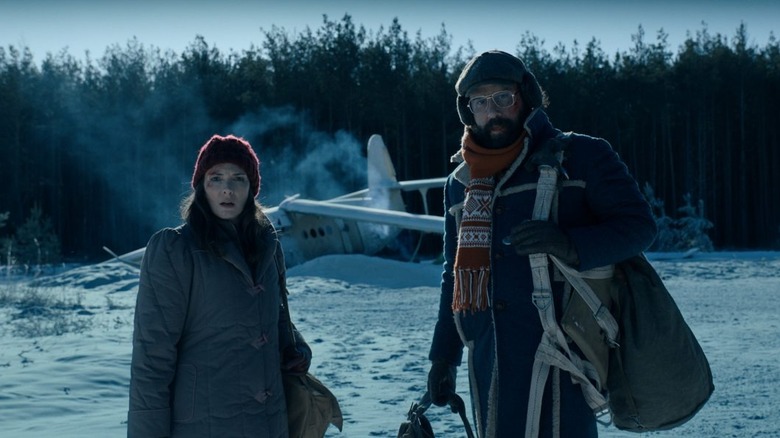
When we hear the kids' bones breaking in the show, how far and intense did you want those sound effects to go?
Dude, it's crazy. When I first saw the first episode ... I was like, "Wow, that's how we're going to go, okay. We're going to get pretty aggressive." It's pretty aggressive and violent, which I was cool with because I've done a ton of movies for Robert Rodriguez. I'm actually doing one right now for him. And he's leaned heavily into the Grindhouse world, a lot of gore. It's right in my wheelhouse, so I was like, "Oh, f***, we're going to go really into the gore here." So I got a lot of those scenes early and they wanted it to be pretty disturbing, pretty shocking. And so, it was a similar thing -- we just went into like, "How can we get this to feel as disturbing?" I mean, they're breaking ... they're kids, you know?
It was actually shocking. We just leaned into it and just tried to make it hardcore, nasty, aggressive. The whole season is very aggressive. We definitely did that with the sound. Even, if you notice, with the stingers, and the risers, the jump scares, it's all just very aggressive, gritty, and a lot of feedback. We used a lot of feedback. There were a lot of distortions, things like that we went into.
Even though you got more aggressive with the sound effects, you also had more fun in some instances, like the airplane fight, right?
That's funny you mention it. I built a whole new palette of fight sounds for that to make it fun, but also hefty, because I wanted everyone to get a feel of like, "Wow. Murray can actually fight." I love that actor who plays Murray. I feel like he kind of steals every scene he's in. He's so funny.
Craig and I were talking about it and the idea was to have an homage to Bruce Lee, but not to [fully] go into the kung fu stuff, but to just give a little hint to it. If you notice, at the very end of the fight, there's a little hint of a gong going off.
Actually, we really went way Bruce Lee in the first pass. We had the Bruce Lee vocal, all the kung fu voice stuff that he did, little hints of it. At the end, we had the big gong. But the gong is still in there, it's just very subtle. It's that moment where he just knocked him out and it zooms in on him, and then we have the little Bruce Lee moment. But yeah, that was a blast. That was super fun to do that scene.
'Once I Tell You What I Use, You'll Never Hear It The Same After That'
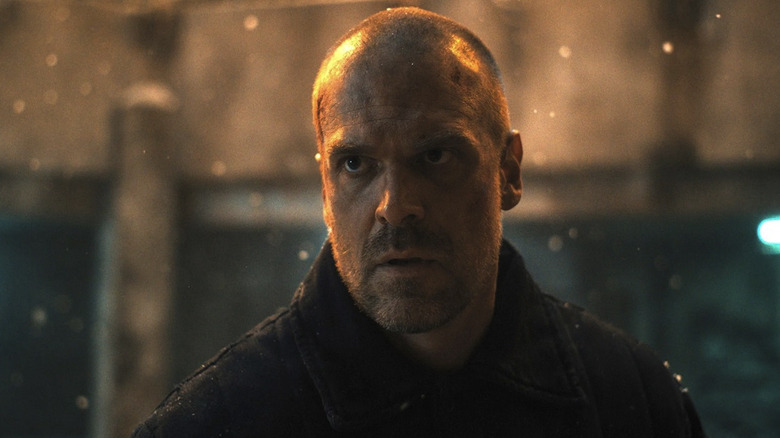
A contrast to that fight scene is Hopper's prison escape. You have explosions, gunshots, and the battle with chains and tools, not to mention a snowmobile. How massive of an undertaking was that action scene?
It was massive. The whole thing was just so big. We were all saying throughout the whole series how big it is. We all come from feature backgrounds, we're all weathered veteran feature film designers and editors, and we've also done episodic, but then this was a hybrid of the two. Hats off to the Duffers and the Zimmerman guys who cut the picture to this stuff, because the pasting is amazing. Like you said, all the moving pieces, but it all works, and the action is just this high-octane action that gets in and out of these scenes. It was like cutting a feature, it really was. I'm actually doing a movie now that is a feature and it feels like a walk in the park now compared to what we just did on "Stranger Things."
To your question, with Hopper, we were going for more of just realistic violence. With Hopper, the whole idea with the prison, the Russian scenes was, "This is brutal." The hits are nasty, the punches are painful, and they just feel real. We were going at it like, "How do we contrast these two fights?" It was mostly to keep his stuff raw and real-sounding.
I wanted to circle back to using vegetables for the sound of bones breaking. What are some other funny practical elements you were using for sound effects?
You know, it's funny, man. I'm so immersed in the sound world that I kind of figure, "Oh yeah, everybody knows that," but people don't know that. We use all kinds of stuff. Well, one thing, I designed a lot of the Creel house, the creaking, and I was trying to give it its own character of this breathing movement thing.
It's weird, because it's so funny when you talk about what you use, it can kind of take the magic out of it. In fact, I remember, I did the movie "Frozen II," and there was the thing called Gale, the wind spirit. After two editors had made an attempt, they gave it to me to try it. I did my version of it and the director loved it and then ended up in the movie, and the entire time they were asking me what I did. I actually said, "I can't tell you, because if I tell you, it'll ruin the movie for you." Once I tell you what I use, you'll never hear it the same after that.
But with "Stranger Things," I don't feel like it's so much the case, because a lot of it is very organic sounds. But with the Creel house, I had this old Ikea furniture that I was getting rid of. There were just these chairs that had these unbelievable creaks when you leaned into this stuff, and I'd had them for so long. I ended up taking the microphone, putting it underneath this footrest type thing. It had this amazing, deep, tonal, heavy, creaking wood sound that I recorded at 192 [kilohertz], which allows me, later, to pitch it down without having any weird artifacts in the audio.
I started with that, this piece of Ikea furniture, just really manipulating the wood, just stressing it, bending it as much as I could. It had these great bending sounds that worked incredibly for the Creel house. Once I pitch it down, and then I start layering in some other elements, and I get this breathing quality in the house, that this thing is weirdly alive, which we later find out it is when the vines come to life. It was something that really was an unusual source that helped out a lot with the Creel house.
'Push The Boundaries And Get Out Of The Box Here'
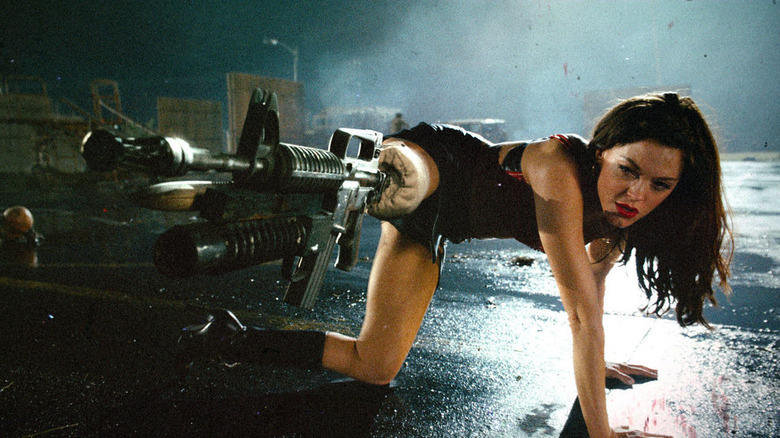
The Duffer Brothers are very referential. Obviously, this season is very indebted to "Nightmare on Elm Street." Do you ever pay homage or reference classic movie sound effects or techniques in "Stranger Things?"
Sometimes. There are some vocal moments with the house, I think, with some of the stingers, where we were doing a bit of reverse vocals, "Poltergeist"-style, just to hint at that early '80s reverse reverbs and reverse whispers and vocals into a moment or a hit. There's a lot of leading into scenes with the whole season, where you have a rising lead-in that drops you into some action in the next scene. The pushing movement, that momentum, worked well with a lot of these reversing, fluttery, "Poltergeist"-y sounds. That was one.
I actually went back and listened to some of the stuff that [composer and sound designer] Alan Howarth did, who I worked with way back when I started out. I was his assistant years ago and I asked him how he did all that stuff. I think it's pretty common knowledge, now, how he did it, but it was fun to be able to actually ask him, and Alan did all those "Halloween" sequels. I got a ton of great tips through the years from Alan, as far as approaching the horror movie genre.
I did look at the "Elm Street'' stuff again, because, I mean, I don't think the Duffers are trying to hide any of that, either. They're right out there. I mean, part of the appeal of the show is for someone like me who grew up in the '80s. I was their age in '86. I was 15. So, to me, that's super-nostalgia. I think it's all about that. They're all about putting the influences right out there.
In chapter seven, the Demogorgon vs. the prisoners, obviously a lot is happening there. What was challenging about working on that fight sequence?
There's a massive thing. To be honest, the whole thing was so challenging. It really was, I feel like all of us, the whole sound team, everything we did took all of our game to the next level because honestly, none of us have worked on an episodic show that was this long, just in pure length of each episode, with this much action, this much sound design, the effects editorial was super stylized with all the fast cuts and the action scenes. It just took so much skill on this show, and everyone did such an awesome job. Any of the Demogorgon scenes were definitely challenging to know where the point was to notch them up to the next level. Their movements were more aggressive, the vocals were more aggressive.
As you said, some of the movies referenced, you were watching them when you were 15. When I was 15, I was watching "Grindhouse" in the theater. Since it's the 15th anniversary this year, any fond memories working on that movie?
Oh yeah, man. The first movie I did for Robert was "Sharkboy and Lavagirl." And then right after that was "Grindhouse," which, it's this crazy juxtaposition that he does, this crazy dichotomy of movies, where he's got these kids superhero movies and then these uber ultra-violent grindhouse movies. So that one was a blast because, my memory is just I couldn't believe we were going so far with the gore and the violence in these movies, but then it was so much fun that it was almost bordering on humor. He likes the campy, over-the-top stuff.
I kind of solidified my position with the crew on that movie because I just went full-on. I was like, "All right, I'm going to have a lot of fun with this. I'm going to go big." I created a lot of these over-the-top water slasher-type stuff, blood squirts. When there's blood in Robert's movies, it doesn't just splat -- it squirts and it keeps going.
I guess my memory is knowing that I can push the limits, and it's a lot of fun working with people who appreciate that. Also, it's funny, man, that you tie it into this, [because] that's when I met Craig Henighan. We worked on "Sharkboy and Lavagirl'' and then again on "Grindhouse." I met him in the Rodriguez movies, and Craig loved what I did and ended up bringing me onto "Fantastic Four," and the rest is history with us. We've done a ton of movies after that.
My biggest memory with that is it really helped set the tone for my career in a lot of ways, because it helped me kind of be like Robert's crews where everyone's reckless. Reckless in the sense of like, "Dude, do whatever you think is going to work and have fun with it and push the boundaries and get out of the box here." We all do that and it's set the tone for me from that point on of, there's no right or wrong here. We can just have fun with this. We all have backgrounds in bands and music, so we kind of bring a bit of a musical, tonal, rhythmic element to what we do.
I never really tied it all together before, but I did meet Craig in that world. Here we are 15 some years later, we're still doing it, and now we're doing f***ing "Stranger Things," which is insane. "Stranger Things" was totally insane.
Volume 1 of "Stranger Things" Season 4 is now available on Netflix.
Read this next: The 19 Greatest Movie Couples Of All Time Ranked
The post Stranger Things Sound Effects Editor Angelo Palazzo on The Magic of IKEA Furniture and Vegetables [Interview] appeared first on /Film.
Jurassic World Dominion Review: For The Love Of T-Rex, It's Time To Let This Franchise Finally Go Extinct
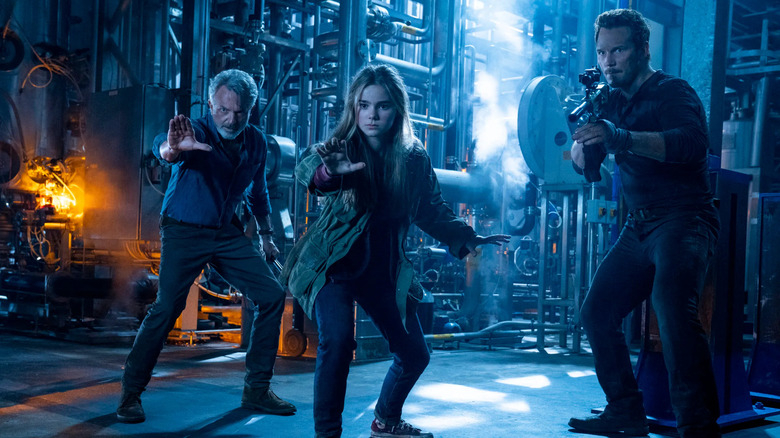
In 1993, Steven Spielberg's "Jurassic Park" changed movies forever. That's not hyperbole or exaggeration. Spielberg, working with a crack team of special effects artists, made us believe dinosaurs were back, if only for the runtime of the movie. Digital VFX work had been used in films before "Jurassic Park," but it was Spielberg's monster movie opus that displayed such work on such a grand, impressive, immersive scale. In the wake of that film, Hollywood would fully embrace digital effects — for better and, in a lot of cases, for worse. No one would accuse the film, adapted from Michael Crichton's pulpy sci-fi page-turner, of having a brilliant, air-tight script. But whatever it lacked was more than made up for by the work done by Spielberg and company. Ultimately, "Jurassic Park" did what so much of the best of Spielberg's work does: it reminded us that movies can be magic.
Whatever magic Spielberg caught in a bottle in that first "Jurassic Park" has long since evaporated. Not even the filmmaker himself could reclaim it, returning to helm the nasty, effective, but not nearly as-good sequel "The Lost World: Jurassic Park" before handing the third film, "Jurassic Park III," over to Joe Johnston. That threequel was a fun, fast B-movie with a big budget, but a lackluster reaction more or less rendered the franchise extinct. That changed when Colin Trevorrow came on the scene with "Jurassic World," a legacy sequel that asked, "What if we took all the stuff that made Spielberg's original so great, and made a less-entertaining movie?" Critics were not impressed, but it didn't matter — "Jurassic World" was a dino-sized hit, and spawned a sequel, the odious "Jurassic Park: Fallen Kingdom." That, in turn, spawned what is reportedly (please, god, let it be true) the final entry in Trevorrow's legacy sequel trilogy: the brain-dead nothingness that is "Jurassic World Dominion."
Less a capper to a franchise and more a series of loud, ugly scenes with absolutely no weight or life, "Jurassic World Dominion" tries to entice us by luring back the original trio of Dr. Alan Grant (Sam Neill), Dr. Ellie Sattler (Laura Dern), and Dr. Ian Malcolm (Jeff Goldblum). The prospect of having that team back on board sure is nice, in theory, especially since the human characters in the "World" trilogy have all been abysmal, dull, and unlikable. But no matter how charismatic the three actors are (and they are!), they can't rescue a clunky, shockingly boring movie that ends with a frail whimper rather than a T.rex-worthy roar. How can you make a movie about dinosaurs boring? "Jurassic Park Dominion" found a way!
Big Bugs
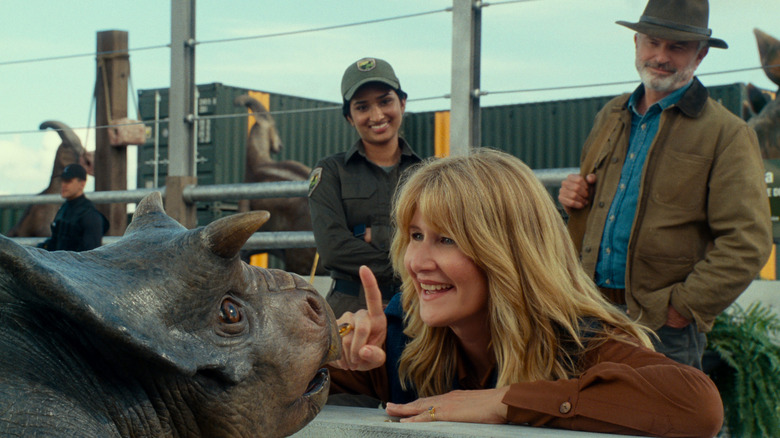
"Fallen Kingdom" ended with an admittedly interesting scenario in which those pesky cloned dinosaurs, free of a secluded island habitat, escaped into the real world. Our world. The trailers for "Dominion" would have you believe that the film is set in some sort of post-apocalyptic wasteland where dinosaurs are back on top and humans are struggling to survive. If that's what you're expecting here, you've been misled. Aside from a clumsy bit of exposition at the beginning of the film, complete with a montage of several dinosaurs out and about among humans, nothing seems all that different here.
We learn that while a few tiny dinos are kicking about, most stray dinosaurs have either set up their own home in a national park, or they've been rounded up by Biosyn, a gigantic company with their own dinosaur habitat. Of course, we know from both these movies and the real world that giant, obscenely wealthy companies are always up to no good, and sure enough, Biosyn has nefarious goals. The company is the brainchild of the smarmy Dr. Lewis Dodgson (Campbell Scott), who you might remember as the character who handed Wayne Knight a fancy can of shaving cream in the first "Jurassic Park." Dodgson believes he can use dino DNA to help cure various diseases. How? Don't worry about it. It's little more than a line of dialogue tossed off to justify the plot.
And oh yeah — there are big bugs now! Specifically, a swarm of giant locusts (we're talking the size of house cats here) has begun decimating the country, gobbling up crops. Not to worry — Dr. Ellie Sattler is on the case! She wisely tracks all of this back to Biosyn, and recruits her old colleague and former boyfriend Alan Grant to help her get to the bottom of things. They fly off to Biosyn's secluded headquarters, and wouldn't you know it? Dr. Ian Malcolm is working there! Can these three characters team up to stop ... *checks notes* ... giant insects?
Do you even care?
'Jurassic World? Not A Fan'
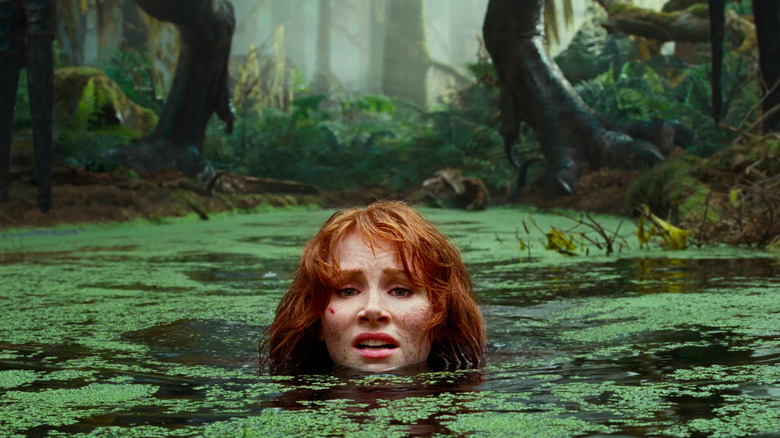
But of course, we can't just focus on that original trio. There are the "Jurassic World" characters, too! Remember them? It's okay if you don't, because they're some of the most uninteresting characters to ever grace the silver screen. When I say Allan Grant, you likely have a whole bunch of characteristics in mind: gruff and rough around the edges but ultimately kind; a guy who hates kids at first but comes along to liking them; a man at the top of his field; a researcher who loves getting down in the dirt and digging. Now, when I say Owen Grady, what do you think of, other than, "Who the hell is that?" Chris Pratt's "Jurassic World" character is a void; there's nothing to him other than the fact that he's supposed to be cool and handsome. Pratt can be charismatic and likable when he's playing goofballs, but this series has unwisely decided to have him play his character 100% straight. He's supposed to be a rugged adventurer, I suppose, but he seems more like a robot; an automaton with perfectly groomed stubble and a fondness for vests.
Owen and his girlfriend Claire (Bryce Dallas Howard), a former Jurassic World head honcho trying to make up for the mistakes of her past, are in hiding with Maisie (Isabella Sermon), a child cloned using the Jurassic Park technology. Maisie is a teenager now and doesn't want to stay in hiding forever, and sure enough, she ends up being kidnapped, along with Beta, the child of Blue, Owen's best bud who just happens to be a Velociraptor. Owen seems more broken up about the baby raptor's abduction and promises Blue that he'll get her back. "You made a promise to a dinosaur?" Malcolm observes later, as if saying it out loud absolves the script of its stupidity. Hey, "Jurassic World Dominion," pointing out how dumb you are doesn't help matters. It just reminds us of how dumb you are.
With all these pieces in place, "Dominion" starts to feel like a globe-trotting Bondian spy movie that just happens to have dinosaurs. A spy movie with dinosaurs actually sounds like a fun idea, but there's no fun to be had here. The action set pieces are flat, rendered in such a way that we never once believe any of the characters are in danger. Remember how terrifying that T-Rex attack was in the original movie? Remember all the amazing action that followed? You won't catch even a glimmer of that here. Instead, Trevorrow decides to spend huge chunks of the movie with characters standing around in darkened rooms, having hushed conversations about nothing in particular. Dern is the only performer here really trying to carry the movie, while Neill and Goldblum both seem simply happy to be along for the ride. Pratt has never been more boring, and Howard has almost nothing to do. DeWanda Wise is a bit more memorable as a Han Solo-like smuggler who helps our heroes out, but she feels ported over from a different, better movie.
I know nothing I say here will ultimately matter. These movies seem destined to make a killing at the box office, and I'm sure "Dominion" will be another hit that Trevorrow can lay claim to, even though we'd probably all be better off if he retired from filmmaking and went and did something else instead. The "Jurassic World" trilogy is finally over, and we can only hope the powers that be will wait a while before returning to this cash cow (or cash dinosaur, I guess I should say). And when that happens, here's hoping they find a better filmmaker to steer the ship. Someone who can try to rekindle that magic. At one point in "Dominion," Ian Malcolm says, "Jurassic World? Not a fan." Me neither, Ian. Me neither.
/Film Rating: 4 out of 10
Read this next: 20 Movies About Time Travel Ranked Worst To Best
The post Jurassic World Dominion Review: For The Love of T-Rex, It's Time to Let This Franchise Finally Go Extinct appeared first on /Film.
The Munsters Trailer: Rob Zombie Resurrects The Frightful Family
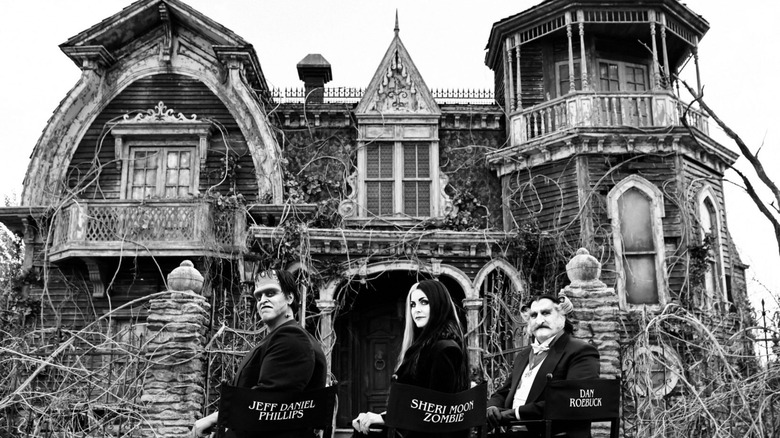
After months of sneak peeks from the set of Rob Zombie's adaptation of the memorable monster sitcom, "The Munsters," the time has finally come where we're getting our first real look at what he has in store. The film marks a departure from Zombie's usual filmmaking style, which tends to favor gritty and filthy graphic horror with films like "House of 1000 Corpses," "The Devil's Rejects," and his "Halloween" remakes, but "The Munsters" marks his first foray into family-friendly filmmaking. Even his animated flick, "The Haunted World of El Superbeasto" is rated R, just to give you some context. Zombie hinted at the arrival of the teaser trailer yesterday on Instagram when he posted the classic pre-movie bumper for Universal Pictures, paying homage to the time period in which "The Munsters" first debuted.
The beloved sitcom has been delighting audiences for nearly six decades, thanks to a combination of family-friendly hijinks and plenty of monster fun. Rob Zombie has been trying to get a film version of "The Munsters" made for years, and the influence the show had on him has been front-and-center for the entirety of Zombie's professional career. The prolific musician-turned-filmmaker is arguably best known for his song "Dragula," which is a play on the "Drag-U-La" drag racing car Grandpa makes in the episode "Hot Rod Herman."
Now, we're finally getting the chance to see a bonafide passion project, and it's clear from the teaser that Zombie put his heart and soul into honoring the integrity of "The Munsters." But he wasn't afraid to present the iconic characters in a way that would appeal to current audiences, too.
The Munsters Teaser
It's impossible and unfair to compare the performances of Jeff Daniel Phillips (Herman Munster), Sheri Moon Zombie (Lily Munster), and Daniel Roebuck (Grandpa) to that of the original cast, but it's been clear from even the earliest posts from Zombie on Instagram that everyone involved in the project has a great deal of love and respect for the source material. Zombie has never shied away from highlighting horror favorites in his projects, and "The Munsters" was no different.
In addition to the aforementioned trio, "The Munsters" also features performances from Richard Brake ("Game of Thrones"), Catherine Schell ("On Her Majesty's Secret Service"), Sylvester McCoy ("Doctor Who"), Jorge Garcia ("Lost"), Roderick Hill ("The Witcher"), Mark Griffith ("SAS: Red Notice"), Tomas Boykin ("3 From Hell"), Jeremy Wheeler ("Houdini"), Cassandra Peterson ("Elvira: Mistress of the Dark"), Dee Wallace ("E.T.: The Extra-Terrestrial"), and one of the original Marilyn Munsters, Pat Priest.
"The Munsters" is due out this Halloween season.
Read this next: 16 Horror Movies That Ruined Everyday Activities
The post The Munsters Trailer: Rob Zombie Resurrects The Frightful Family appeared first on /Film.
Review: The Quarry

They've still got it
While we wait for the next entry in the Dark Pictures Anthology, Supermassive Games is dishing out even more choice-based horror in its familiar cinematic style. And this time, it's the big one — the moment fans have been waiting for since Until Dawn. From the outset, The Quarry tries to recapture that lightning in a bottle in terms of scope, story, and execution, and this supernatural end-of-summer-camp adventure hits the mark.
Evil is afoot, and your decisions will once again dictate who makes it to sunrise.

The Quarry (PC [reviewed], PS4, PS5, Xbox One, Xbox Series X/S)
Developer: Supermassive Games
Publisher: 2K Games
Released: June 10, 2022
MSRP: $59.99 / $69.99
The Quarry is a standalone new IP — it doesn't belong to Bandai Namco's Dark Pictures series — but there are so many shared traits. And the refinements are stacking up.
If you've been on any of Supermassive's wild rides before, you know what to expect by now — familiar faces from film and TV, lots of chatting, quieter clue-finding moments, plenty of frantic quick-time events, a guiding force in between chapters, and some gut-feeling life-or-death calls. The Quarry covers all of those bases, and it covers them well.
These games are at their best when they leverage classic horror while also infusing some modern touches, meta moments, and well-timed laughs, which can be a tough act to sustain. The best ones know when to fluctuate between tension, drama, and levity, while also seeding enough mystery to keep you speculating about where the story's headed next. The Quarry hit those marks for me. It has some of the best-written Supermassive characters yet — a bunch of disobedient, but capable (!), teenage camp counselors trapped overnight — and a few major story threads that collide in an interesting way.
I already said the magic word (supernatural), and I'll just add that The Quarry has its own fresh spin on a horror trope that I'm not spoiling. You'll figure out what it is before it's fully shown, but the way it happens is exciting, and there are more layers to wrap your head around before the night is over. The game does a good job of splitting up the protagonists into sub-groups and bouncing all around, chapter after chapter, to keep the energy up until the end. And I was surprised by how some of the NPCs fit into the bigger picture. Everything ended up being connected in an at times unpredictable, yet satisfying, way.

You'll surely recognize at least some of The Quarry's extended cast, which includes Ariel Winter, Justice Smith, Skyler Gisondo, and Ted Raimi, as well as smaller appearances from David Arquette, Lance Henriksen, and Lin Shaye. As a Twin Peaks fan, I particularly enjoyed Grace Zabriskie's (collectible) tarot card readings — she's my favorite fourth-wall-breaker yet — and also Siobhan Williams, who really comes into her own later in the story.
While many of The Quarry's elements can be traced back to Supermassive's prior games, I think this streamlined presentation is a step up, whether it's hazy "here's how you might die!" premonitions, extra touches like morbidly funny animated tutorial sequences, and new prompts. You can tone down the QTEs so you never really have to worry about failing them, and there are slightly more thought-provoking moments when you can optionally interrupt someone (but maybe shouldn't...) or hold your breath in hiding (until the exact right moment when the coast is clear). The dialogue flows well, and I chuckled a bunch.
As for the branching story, when I hit the credits, I immediately wondered how things could've gone off the rails in a totally different way based on any singular decision. Throughout the game, you'll see "Path Chosen" pop-ups after significant (and seemingly insignificant) events, which you can track in a nice visual way in the pause menu, though it's often tricky to suss out what's next. When making choices, figuring out whether or not to trust your gut is a big part of the fun. Sometimes, the safe choice is super dangerous.
My most anxious moment involved dropping an important item in a lake at night with razor wire swaying under the surface. I'm shuddering just thinking about it.

Not everyone will want to pay the full premium price at launch for a cinematic horror game like this, and I feel like that's worth acknowledging — it's fair to bring up. The value will vary from one person to the next, especially if you're not playing in a group, which is often the ideal way to go. One of the main questions is undoubtedly going to be "how long is it?"
Playing alone, The Quarry took me around nine hours, though I missed quite a few world-building collectibles, and spent some extra time replaying sequences with the Death Rewind feature, which can kick you pretty far back depending on the circumstances. Your runtime will depend on your choices, your thoroughness during exploration, and the game mode. There's solo, couch co-op, a streamlined sit-back-and-watch Movie Mode, and online multiplayer (which is coming out after launch due to a last-minute delay).
To give a better sense of the game's scope, there's a decently long prologue and ten chapters. You'll want to get cozy, because The Quarry is likely a three-sitting game. I originally planned to squeeze it into two nights, but I'm so glad I spread it out. Several scenes would've been too much of a slow burn for me without a breather, though your patience — or group setting — might make a marathon session more feasible.
I don't want to say many specifics about the setting, but Hackett's Quarry has a nice spread, with plenty of variety, so don't think it's "just a campsite." Even though this is a linear game that funnels you from scene to scene, it has an appropriately big presence.

Despite the Dark Pictures Anthology's unevenness and some frustrating tonal choices (sorry to open that can of worms again), I've been down for every Supermassive horror game so far. Even when they don't blow me away, they're still enjoyable. I'm happy to say that The Quarry is easily at or above Until Dawn, and while it doesn't have quite the same impact — the formula isn't as fresh at this point — it's a much more refined game. It taps into comfy '80s horror nostalgia while feeling modern and standing on its own two feet.
There are more ways than ever to adjust the challenge to your liking with granular accessibility settings, and the story has fun tricks up its sleeve for horror fans to untangle as they try to snap together the different story pieces in play. I'm also shocked by just how good these production values have gotten — depending on the framing and lighting conditions, certain shots approach photo-realism for me. I wasn't sure I'd mesh well with all nine of the teenage protagonists, and they did need to grow on me (and one never did), but they all ended up being memorable in their own way. Though there's a lot of upfront banter, some of which lands well, and some of which is groan-worthy, the counselors are layered, and it's interesting to think through the choices that dictate their future.
While I can't say I'm dying to do another full playthrough immediately — this is not a short game! — I will say I was into The Quarry just about every step of the way. I'm stoked to see some alternate pathways and gnarly deaths when they pop up on YouTube, and I'll do a second run sooner than later. I'll be in the mood again by Halloween for sure.
The Quarry is just as good as I was hoping it would be, and that's a pleasant surprise.
[This review is based on a retail build of the game purchased by the author.]
The post Review: The Quarry appeared first on Destructoid.
The Unbearable Weight Of Massive Talent Ending Explained: A Very Meta Nic Cage Love Letter
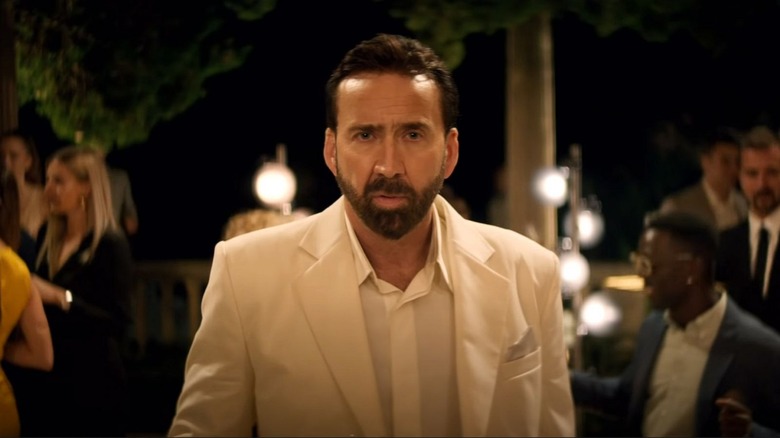
For my money, the funniest film of 2022 so far is "The Unbearable Weight of Massive Talent." It's a film that lives and dies on its star — because in "Massive Talent," Nicolas Cage plays himself, or at least a fictionalized version thereof. The in-film Cage has the same filmography, but whereas the real-life Cage recently gave one of his best performances in 2021's "Pig," the movie's Cage is trapped in a rut, having just lost out on a part in the newest David Gordon Green film and continually alienating his ex-wife Olivia (Sharon Horgan) and daughter Addy (Lily Sheen).
With no other options, Cage accepts a $1 million invite to Majorca to be a guest at the birthday party of Javi (Pedro Pascal), his number one (and richest) fan. Javi's passion and fanboyism rub off on Cage, restoring his passion for acting. After befriending Javi, Cage is recruited by CIA agents Vivian (Tiffany Haddish) and Martin (Ike Barinholtz), who believe Javi is the boss of an arms-dealing syndicate that has kidnapped Maria Delgado, a local presidential candidate's daughter. Cage then asks Javi to write a screenplay with him as cover to stay on Majorca and investigate the compound for Maria's location.
Spoilers for "The Unbearable Weight of Massive Talent" follow.
An Ending Worthy Of The Silver Screen
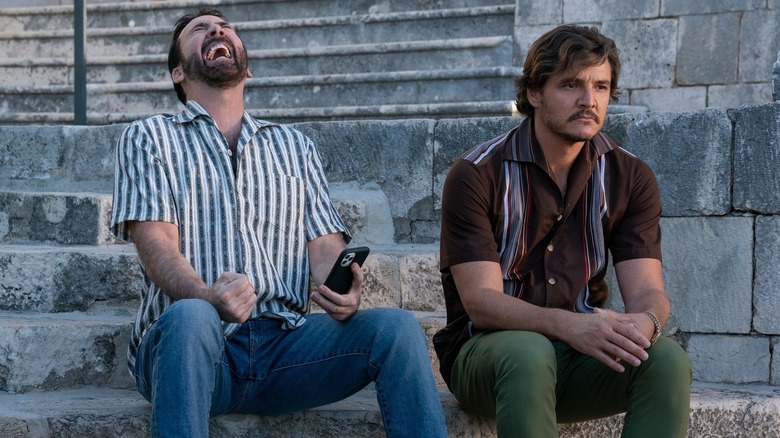
As Cage jokes, the CIA puts him in the position of "Donnie Brasco," the 1997 film about FBI agent Joe Pistone (Johnny Depp) infiltrating the mafia with the titular alias. Javi is Cage's very own Lefty Ruggiero (Al Pacino). A hero forced to spy on a friend and come to terms with that man being a criminal isn't treading any new ground in Hollywood; however, here it ends much less tragically than usual because it turns out Javi is not a crime boss — his cousin Lucas (Paco León) is.
Unfortunately, before Cage learns this, Javi has invited Olivia and Addy to the island. Cage interprets this as a threat, while Javi is ordered to kill Cage by Lucas after the latter discovers Cage is working with the CIA. Neither Cage nor Javi can kill the other, but by the time they realize each other's intentions, Lucas has kidnapped Addy. Comedy gives way to action-comedy as the two team up to rescue Addy and Maria.
The climax of "Massive Talent" is set to be a shoot-out between Cage and Lucas, but just before it commences, the film match cuts to an in-universe movie of Cage playing a double-fictional version of himself. It turns out that Cage and Javi did end up making a movie together, one based on the birth of the friendship and adventure in Majorca. Once this movie ends, we see the main characters enjoying it at the premiere.
Face/Off's Influence
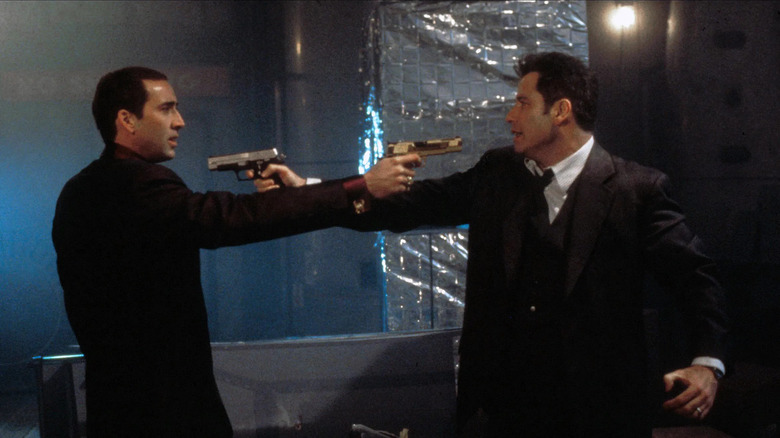
"Massive Talent" is a love letter to Cage's career with references galore. Characters are seen watching his 1997 Jerry Bruckheimer joint "Con Air," while Cage is haunted by an apparition of his younger self, "Nicky," who looks straight out of "Wild At Heart." However, there are two Cage movies to which "Massive Talent" owes the greatest debt.
One is John Woo's "Face/Off." That title is an all-time double entendre; terrorist Castor Troy (Cage) and FBI agent Sean Archer (John Travolta) swap faces and spend the film, well, facing off. "Massive Talent" is littered with references to "Face/Off": Javi identifies it as one of his three favorite films, alongside "The Cabinet of Dr. Caligari" (which Cage had failed to get Addy interested in) and "Paddington 2" (which he then introduces Cage to). It turns out Javi likewise owns a wax replica of Castor Troy (Cage offers him $20,000 for it) and the golden guns which Cage used in "Face/Off." Cage gets to use the guns once more as the action ramps up.
Both films also have dual leads. Neither Archer nor Troy (and by extension Travolta and Cage) can be considered more of a star in "Face/Off" than the other. "Massive Talent" may be sold as the Nic Cage show, but like Travolta before him, Pedro Pascal's screen presence rivals his co-star's.
Why does "Face/Off" get so much focus? "Massive Talent" banks on the popularity of Nicolas Cage memes. The hyper-stylized tone of "Face/Off" means that it contains plenty of the overacting which made Cage a favorite of the internet.
Adapting The Structure Of Adaptation
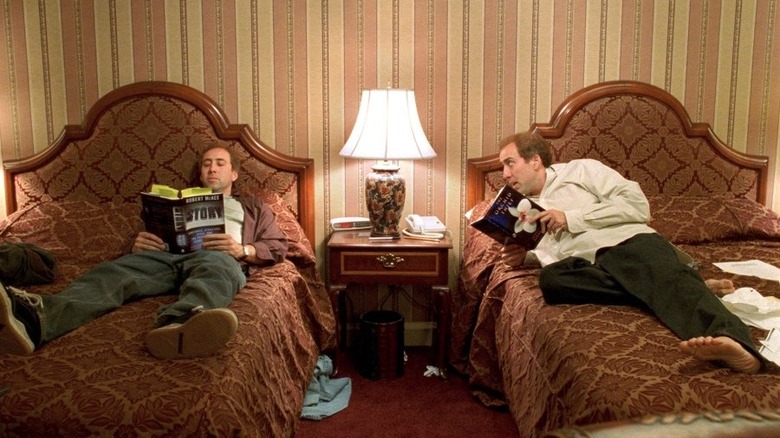
The other Cage flick which casts the longest shadow over "Massive Talent" is Spike Jonze's "Adaptation." The script doesn't name-drop it as often as "Face/Off," but its influence is even more vital. In "Adaptation," Cage also played a real-life Hollywood figure, namely the film's screenwriter, Charlie Kaufman. Kaufman had struggled writing a script to adapt Susan Orlean's "The Orchid Thief," so he wrote a movie about his writer's block instead.
The first half of "Adaptation" is purposely aimless, oscillating between Kaufman's professional and personal struggles and flashbacks to Orlean's (Meryl Streep) experiences with horticulturist John Laroche (Chris Cooper) that inspired the book. The film becomes more conventional in its second half, when Charlie starts listening to the advice of his brother Donald (also played by Cage) and Robert McKee (Brian Cox). Kaufman's mode of writing shapes the world around him.
"Massive Talent" uses this same sort of reflexive bait-and-switch. As Cage and Javi develop their screenplay, their ideas reflect their real-life circumstances. The two initially pitch the movie about a friendship between two men, much like themselves. At Vivian's demand, Cage suggests turning it into an action film about the leads rescuing one of the men's kidnapped daughter. This beckons Olivia and Addy's reintroduction and the transformation of "Massive Talent" from one about an unlikely friendship into the exact kind of action film Cage pitched to Javi.
By aping the narrative progression of "Adaptation," "Massive Talent" delivers a double blow. It's not just a meta film because it features Nic Cage playing himself and referencing movies he's been in, the fact that it's meta-text is itself a reference to a Cage movie.
Defining Meta-Text
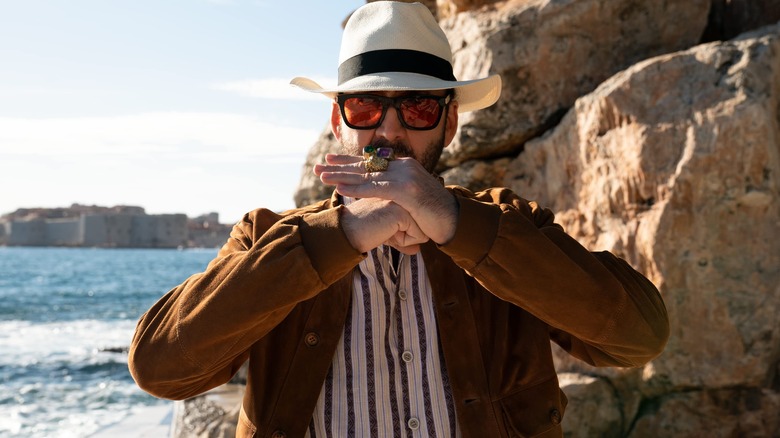
Both "Adaptation" and "Massive Talent" are meta-texts — the two films are about the authorial process, specifically in film-making. The movies metatextually reference their own creation, while they also metafictionally draw attention to the artificial nature of their stories.
"Adaptation" implies that Charlie's script is the basis of the film we just watched — after all, that's what the real-life Kaufman wrote. "Massive Talent" ends with the characters watching a cheesier version of the film we just did, albeit with Demi Moore as Olivia and Anna MacDonald as Addy.
Both "Massive Talent" and its in-universe counterpart are action films, despite Javi having previously lambasted Cage's pitch as "terrible." Cage (echoing Vivian) countered that such a plot is needed for wide appeal. This could easily be read as the filmmakers acknowledging their own compromises they made in getting "Massive Talent" made. I don't think it's quite self-flagellation though since Cage ends the film with the comeback he wanted and Javi is now the filmmaker he'd dreamed of being. The lesson? Compromise doesn't have to stifle creative fulfillment. Cage applies this lesson to his personal life by letting Addy pick the film they watch together; it turns out to be "Paddington 2"
The movie premiere conclusion also turns "Massive Talent" into an ouroboros of meta-text; just as a serpent devours its own tail, a film where Nicolas Cage plays himself features a fictional film where the in-universe Nicolas Cage plays a double-fictionalized version of himself. The only thing missing is an in-movie Javi telling Cage they should make a movie about their experiences. It also underlines the conceit of the joke that animated it; Nicolas Cage is such a fascinating and eccentric man that there should be a movie that doesn't just star him, but is about him.
Read this next: 13 Box Office Bombs That Are Truly Worth A Watch
The post The Unbearable Weight of Massive Talent Ending Explained: A Very Meta Nic Cage Love Letter appeared first on /Film.
We're officially getting a Joker sequel

I liked Joker; I didn't love it. I'm more fascinated by what Joker represents for the future of cinema. I'm sure you've heard the chorus of filmmakers chiding Marvel for ruining movies and making it harder for smaller pictures to succeed. — Read the rest
Gentleman vandalized statue of Betwitched's Samantha in Salem

On Monday in Salem, Mass, a man took red paint to the town's iconic statue of Elizabeth Montgomery as Samantha from the classic 1960s TV show Betwitched. The statue was installed in 2005 amid controversy that it trivializes the tragic 1692 witch trials leading to the hanging of 19 women with other dying in jail. — Read the rest
While AR-15s are "sporting rifles" in congress, retired general major calls them "weapons of war. Period"

Gov. Greg Abbott is fine with 18-year-olds buying AR-15s over the counter in Texas without even a background check. Rep. Ken Buck (R–CO) thinks he needs an AR-15 to protect his chickens. And Sen. John Thune (R-S.D.) refers to AR-15s as a mere "sporting rifle" used to "shoot prairie dogs and, you know, other types of varmints." — Read the rest
EU Working on Possible Ban on Providing Cloud Services To Russia
Read more of this story at Slashdot.
Obi-Wan Kenobi Just Explained A Key Part Of Leia's Backstory
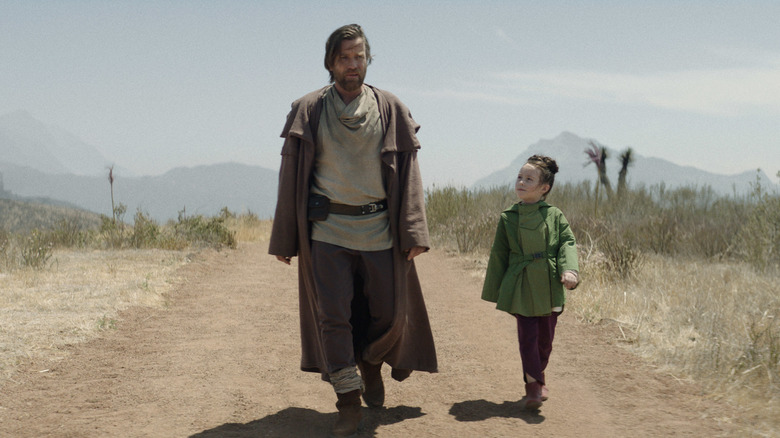
This post contains spoilers for episode 4 of "Obi-Wan Kenobi."
For as much as some fans may loudly complain whenever a new addition to "Star Wars" canon appears to retcon previously established lore, that's actually sort of a rite of passage when it comes to this franchise. "Rogue One: A Star Wars Story" might be the most aggressive example of this, as director Gareth Edwards crafted an entire movie to explain away the "plot hole" of the first Death Star containing one critical design flaw. George Lucas himself did this several times over, first with the reveal that Luke and Leia were actually twin siblings in "Return of the Jedi" and later packing in as many explanations (and, occasionally, outright contradictions) throughout the prequel films. It's simply not "Star Wars" unless you're actively filling in the blanks of what came before.
The ongoing Disney+ series "Obi-Wan Kenobi" is only the latest example of this, revealing what the title character had been up to during those long years of isolation and exile while haunted by his memories of failing Anakin Skywalker. The addition of Princess Leia as a child caught many viewers by surprise, but the lovable dynamic she's forged with jaded old Ben Kenobi has quickly become one of the show's biggest highlights.
After last week's episode ended with Leia in grave danger, once again ensnared by the Inquisitor Reva and at the mercy of the Empire, episode 4 served up a thrilling prison break as Kenobi and his rebel allies attempted a daring rescue. But one easy-to-miss detail revealed during Leia's imprisonment just might go a long way towards revealing a crucial element of her backstory, which only truly comes to fruition in the original trilogy and the sequels, as well.
Strong In The Force
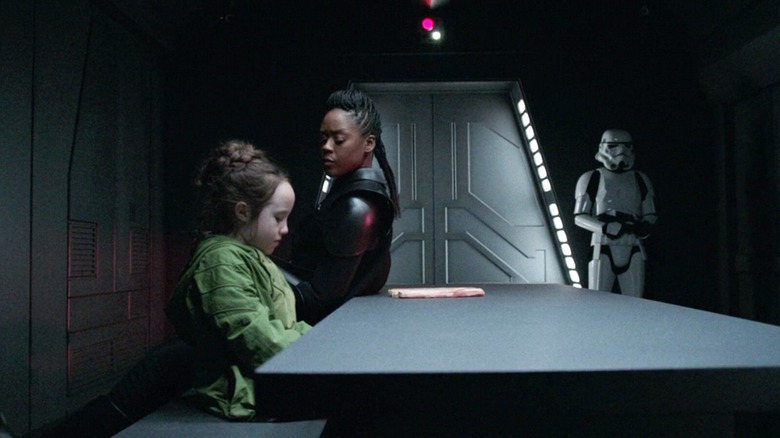
So far, "Obi-Wan Kenobi" has wrung quite a lot of mileage out of our knowledge of future events. The lightsaber duel in the last episode, which featured Obi-Wan struggling to keep up after closing himself off from the Force for so long and Darth Vader seemingly holding himself back (until, you know, he tried to burn his former master alive in a twisted act of revenge), added impressive new layers to the confrontation we know they'll reenact later in 1977's "Star Wars." The presence of a young Leia Organa, which some have erroneously criticized as some sort of plot hole, only further deepens the meaning behind her plea for help decades later that Obi-Wan is her "only hope."
Now, while in captivity under the merciless glare of Reva, her resistance to some very formidable interrogation techniques may provide clues for future events in the "Star Wars" timeline. When subjected to Reva's Force-probe (a power we've seen many times before), the Inquisitor is taken aback by the child's defiance against her tactics. "Is this a staring contest?" she casually remarks, though we can sense the strain underneath those flippant words.
On the face of it, this feels like another classic example of the headstrong Princess refusing to be cowed or intimidated by anyone, even at such a young age. But upon second glance, might we be seeing Leia's latent Force abilities in action here, giving her just enough time for Obi-Wan to come in and save the day? We know from "The Empire Strikes Back" that Leia could sense Luke through the Force, which "The Last Jedi" and "The Rise of Skywalker" both took to another level. Intriguingly, could this scene help explain one particular hanging thread from the original film, too?
Tying Up Loose Ends
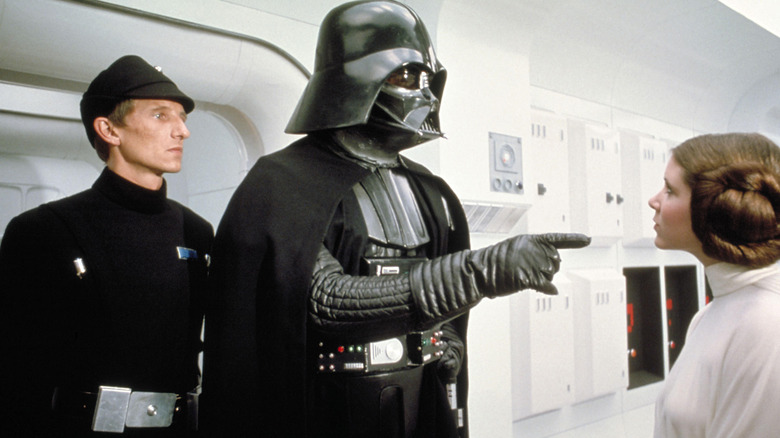
With the benefit of hindsight, the opening moments of "Star Wars" contain deep reserves of dramatic irony -- Carrie Fisher's grown-up Princess Leia comes face-to-face with her father Darth Vader, neither of whom are aware of their relationship with the other. The fact that the unimaginably powerful Sith Lord apparently couldn't even sense his own daughter standing right in front of him or extract the desired information out of her has always caused some fans to scratch their heads, but the latest episode might provide some neat answers ... beyond explaining her well-timed penchant for lying while under duress, that is.
Perhaps Leia's talent for resisting others' Force abilities helps clear things up. Remember, even Reva is forced (pun 100% intended!) to acknowledge that Leia is "strong," pushing back against the Inquisitor with a fierceness seen by few others in the series -- including Benny Safdie's Jedi in the first episode. What if her ability to shut Dark Side users out of her mind completely, even on a subconscious level, explains why Vader himself couldn't break her while she was imprisoned on the Death Star? After all, the fallen Jedi is the one who notes how her "resistance to the mind probe is considerable." It's not the biggest stretch to imagine that this played a significant role in putting up a worthy fight against the Empire's interrogations or, for that matter, unconsciously warding off any possibility that Vader could find out that his own blood is running through her veins, as well.
It's unlikely that any of this will be outright confirmed in the show itself, but for those who enjoy resorting to head-canon to fill in the gaps present throughout this decades-long franchise, this is perhaps one theory that could neatly explain one of the franchise's nerdiest lore questions.
Read this next: The 11 Best Star Wars Droids Ranked By Usefulness
The post Obi-Wan Kenobi Just Explained A Key Part Of Leia's Backstory appeared first on /Film.
A Travelog of Ivalice, Conclusion: DUSK
There are a few characters to whom I’d like to extend an honorable mention. Yes, there are a few characters in the plot that I find interestingly written, and, as I transition from talking about the cast to digging a little deeper, who have a little more going on under the dome. Strangely, all of them number among our enemies— or perhaps not so strangely, if you consider that proximity to our party bears an inverse relationship to being interesting and depthful.
Starting from the bottom and working our way up, I find myself oddly endeared by the Judges Magister, despite most of them appearing in three scenes or fewer. Aside from Gabranth, Judge Ghis is the most prominent in the story, and I think the game uses him well in a nuts-and-bolts sort of way to represent the Empire through the first act of the game before being sacrificed to demonstrate the fatal allure of the nethicite. But Ghis has no interaction with the rest of the Ministry and takes no part in what I consider their most interesting scenes in Archades. As Vayne plays Macbeth above, the Judges Magister find themselves playing a community park rendition of Julius Caesar.
In their introductory exchange they all wear their helmets, making it look and sound a bit silly, but it makes them seem more formal and impersonal, setting up a contrast for later. The looming succession occasions a show of their viewpoints: Drace is more concerned with virtue than with unblinking loyalty, Bergan is a malevolent voluptuary of power, and the elder Zargabaath naturally takes an institutionalist posture, respecting his duty despite his clear concern. Gabranth falls right in the center of these three. He capitulates to the Empire’s power and serves them after the fall of Landis, subverting Dalmasca and damning his brother through deception, finding purpose in life through the dogged fulfillment of his duty. Yet in spite of his misdeeds, his warmer exchange with Judge Drace reveal a sense of virtue that he hopes his duty to Larsa can fulfill.

This scene is paid off when Gramis is assassinated. None of the judges wear their helmets for this scene; in a literal and figurative sense, the masks come off, and their true selves are revealed. Drace rejects her duty for her sense of justice, and is laid low by Bergan, who is loyal to the most eminent person of Vayne, not the Law. Zargabaath does his best to restore order in spite of the travesty. Vayne forces Gabranth to capitulate to his power and choose duty over virtue, ending Drace’s life, leaving him disillusioned and embittered.
But more than serving Gabranth’s somewhat garbled character development, the fate of the Ministry of Law carries a subtext relevant to the game’s flirtations with conflicts of power and duty. The Judges find themselves in an untenable position that demands uneasy compromises between their virtue, their duty, and their loyalty; they cannot satisfy all three, and their fates reveal the measure of their choices: it’s easy to identify with Drace, who acts from a pure heart to strike at the villain before her, but she makes the terrible folly of casting away the dignity and legitimacy of her duty to the Ministry of Law and engaging in a contest of raw power with Vayne: power personified! She immediately loses this struggle, and her life; as Vaan would say, she protected nothing through her sacrifice, and forfeited any future in which she could have done more good. What’s more, her absence further tightens Vayne’s already firm grip on the Ministry as a tool for the enforcement of his whim, and her brazenly lawless attempt on his life clearly demonstrates the state of crisis and treachery that Vayne uses as the pretext for his autocracy— a clever and subtle, if quite rare demonstration of Vayne’s supposed capacity to arrange events such that he emerges all the stronger come what may. Bergan is a much clearer case; he is awed by the majesty of power, and thereby the awesome power of His Majesty, Lord Vayne, and has no regard for that power’s supposed obligation to suborn itself to any higher limiting principle. In the moment, Bergan seems well rewarded for his barbarism, as his own greatly enhanced power is demonstrated in brutal fashion against Drace. But his fate leaves no room for quibbles: a mere tool co-opted and discarded, his mind taken, his soul twisted, and his compromised flesh used up and left to rot… handily foreshadowing the like fate of his master.
Zargabaath, meanwhile, chooses his duty to the Ministry despite the clear offense to his virtue. It’s easy to damn Zargabaath for his seeming cravenness, and I’ve taken my shots at him. But Zargabaath outlasts his peers, and alone outlasts the dark days of Archades to see his honor and his duty at last realigned; he effectively serves as Ondore’s counterpart in the final battle, accepting the cease-fire as commander of the Imperial armada and at once pledging his own life to avert the disaster threatened by the failing Bahamut. Having Zargabaath alone survive the war seems an effective means in itself of demonstrating, if nothing else, the low cunning of keeping your nose down, but if not for Basch suddenly taking the mantle of Gabranth in place of his brother and apparently leading the Ministry of Law under Larsa, Zargabaath’s endurance would have demonstrated (and I suppose still demonstrates) the survival of the institution of the Ministry, and the necessity of keeping its cogs oiled in anticipation for just such a moment long awaited. Yet together with his noble gesture on behalf of the people he only a moment ago fought to subjugate, I wonder at the decision to have Balthier render his offer unnecessary, and his long-stymied virtue demonstrated only in word, not deed. Having Zargabaath go through with his sacrifice would give his sudden turn more weight rather than suddenly taking the wind out of it, but it would also give the audience the karmic retribution and redemption through death that most of them subconsciously crave, and it would at last wipe the slate clean for the Ministry of Law, to be reborn solely under the righteous guidance of Basch-branth… in theory, anyway.

The threat Vayne poses to the Ministry and the Senate is a microcosm of the threat he poses to the balance of Ivalician politics writ large. Outside Archadia, political and military figures like Marquis Ondore or Al-Cid Margrace always speak of their aims in terms of working within a large and complicated network of actors and interests; it’s precisely for the need to assuage what passes for the Ivalician international community of Ashe’s heritage through the implicitly trusted and respected word of an ancient, independent, apolitical institution that we seek out the Kiltias. But just as Vayne overawes the Ministry, the brazen massacre at Bur-Omisace leaves a stunned Ivalice at a loss how to cope with truly arbitrary power they cannot match.
For above the Judges, our main villains play a much grander game.
Dear Doctor Cid seems the most outspokenly ideological of our foes; it’s his words that delineate the putative higher principles for which our foes wage their war. It’s from Cid we take that oft-repeated phrase, “putting the reins of history back in the hands of man.” Quibbles about their means aside, liberating mankind from the machinations of the self-styled arbiters of capital-H History seems a worthy enough goal that our party comes to pursue it in their own way. Does Cid mean it? Nope. By my lights, Cid, who seemed much more personally and morally aligned with Venat than the somewhat transactional and skeptical Vayne ever was, reveals unabashedly at the Pharos a fascination with replacing or becoming the Occuria, not merely ousting them. The struggle against our Undying overseers is revealed not as a liberating revolution, but a coup d’état. Through Cidolfus Bunansa, the game suggests an important lesson regarding ambitious men preaching the glory of man: they tend to have a glorious man in mind— and buddy, it ain’t you and it ain’t me.

Though lacking his entertaining bombast, Vayne has a lot more going on under the hood. In fact, of all the characters in the game, I find Vayne the most complex and interesting of all. In classic character writing fashion, our villain darkly mirrors our hero, Ashe. We, the audience, understand that the convenience of the Occuria’s promise of a virtuous crusade in their interests that will just so happen to deliver on her personal desire to avenge Rasler and the naked eagerness with which they pander to that base gratification demands great scrutiny, all the more as they seem so eager to short-circuit Ashe’s own growing skepticism by this very appeal to her base wants. Likewise, Vayne finds himself at the head of a revolution for the liberation of mankind that will conveniently see him enthroned hegemon of the nations of man. Ashe… for whatever reason… overcomes her temptation to let her personal ambitions too cleanly align with her greater cause; Vayne embraces the convenience.
But what makes Vayne more interesting to me lies beyond his ambitions; that want of power is what Cid and Venat ultimately seek in Vayne, but by necessity they seek it through his beleaguered yearning for a righteous cause. As his impatience with his co-conspirators reveals, the core tragedy of Vayne Carrudas Solidor is that he is ruthless, but not remorseless. From the day he submitted to his father’s command to stain his hands with his own family’s blood, he has believed that stain indelible and his honor irredeemable. Our few early glimpses of Vayne as a charismatic and amiable statesman aren’t merely a false face worn by a consummate schemer, but a look at the man Vayne could have been in another life. Even as he genuinely, almost wistfully admires the naïve purity of Larsa’s optimism and nobility, he no longer believes himself capable of virtue and he accepts that there is no deed too black to further stain his own conscience and thus no great price in honor to be paid for a greater good bought with atrocities. The Emperor wagers ever more of his own soul to the St. Petersburg Game proposed to him by his presumptive friends and allies, more and more believing the next wager his only path to the only stakes that could justify his life: a world that men like his brother may safely inherit from men like him. In the end, Vayne’s fate hardly differs from Bergan’s; though Vayne would agree he must bear the full responsibility for his actions, I believe Cid and Venat were exploiting Vayne from the first.

But Venat was exploiting them both. As difficult as it is to tell what the game is trying to say sometimes, its stance on Venat is crystal clear: Venat is an unspeakably evil being, even more manipulative than the other Occuria and far, far more ambitious and dangerous. Whatever her reasons for spiting Gerun and the Occuria may have been, the sanctity of human freedom has nothing to do with it.
If Venat thought the Occuria’s system unjust, and wanted humanity to determine their own fate free of meddling, why did she not merely destroy the Sun-Cryst immediately? She seems to indicate to Vayne at the end that this was all it really would have taken. The invasions, the Bahamut, the scheming and plots and, above all, the manufacted nethicite… All irrelevant to the goal of “putting history’s reins back in the hands of man.” Far from foreclosing the threat of nethicite and its seductions, she commoditizes it while seeking to usurp the other Occuria’s monopoly on it. The average observer from Landis or Bhujerba, if they didn’t know any better, might conclude that Venat’s actions are aimed less at working against the Occuria or liberating humanity and more squarely focused on building herself an unstoppable army commanded through human proxies or thralls. To play favorites and keep nethicite a secret, sharing it only with your champions, is exactly what the Occuria have been doing, and that’s exactly what Venat does: pick a human agent to accomplish your will, and empower them to do so.

The game speaks of nethicite, and of power generally, not merely as a tool to be wielded but as a force possessed of its own will and its own aims. Those who seek to wield nethicite— to wield power— are likewise wielded by it, we are warned. Venat embodies power itself, lending a mythic personification to this idea that power is not merely wielded by man but seems to wield men to its sole instinctual end: always to grow, to consolidate, to spread like a virus while rationalizing every action nullifying the merest constraint conceived upon it. She seems to want only for a human scion through which to reign, just as the Occuria always have. To Cid, she offers the fruit of knowledge unjustly denied by presumptive gods who fear man becoming like gods themselves. To Vayne, she offers the whole world at the cost of only his sin-sick soul.
This is Venat’s real dream. To let man rule the world, yes. And to let the want of power, through nethicite, to rule their hearts. And, through nethicite, to rule man. This, certainly, is one of the game’s greatest coups: the emergence of Venat as a Satanic figure, ruling through subtlety and lies, through temptation and the perversion of truth. What’s more, it is so thoroughly, beautifully Ivalician: those who seek and love power can only be ruled by it, and one who is slave to ambition can never truly be free.[1] I honestly cannot praise this enough. I love this.
The unsettling likelihood that some sort of idea or theme might actually underlie Final Fantasy XII forces me at long last to breathe aloud a question we were all more comfortable mumbling rhetorically:
What is Final Fantasy XII about?

An obvious answer presents itself: freedom! It’s the one idea that all of our characters, ally and enemy alike, yearn for in one way or another. The battle for freedom underlies the events of the game from beginning to end, unifying the mundane, brute struggle against our worldly oppressors to the philosophical and moral questions of mankind’s place beneath the Occuria and the temptations of the nethicite and the awesome power it holds. Now, with that settled, we can f— waaaait a second, I’m not totally satisfied with this answer.
For what sort of freedom are we really fighting? Well, in the most ambitious good-faith reading of the game, I’m tempted to say that the truest freedom of all is liberation from the ensorcellment of a spurious greater good that marshals our every action to moral compromises, whether or not they’ll ever deliver the omelette as the eggshells stack up. It’s in this sense that we can directly compare our heroes and villains: the internal virtuous struggle that Ashe transcends and to which Vayne succumbs signifies the martial struggle in which they’re engaged and determines its outcome. I think this reading neatly inducts Final Fantasy XII into the fraternity of its Ivalician forebears; while squaring Final Fantasy Tactics Advance with its fellows can be difficult to accomplish honestly, I think each of the games can be fairly read in their own way to glorify heroes— Ramza, Ashley, Marche, and now Ashe— who show their mettle by rejecting the stultifying moral compromises and temptations that prove the prevailing passions of their harrowing times.

Ashe not only turns down the opportunity to gratify her naked vengeance by cleansing Archadia by fire, but rejects the opportunity to unify Ivalice under her standard for what very well might have become a golden age of the sort we’re assured Raithwall accomplished. Raithwall is something of a spoiler to many angles through which we can attempt to read the game, as the text never so much as hints that the epoch of peace and prosperity that he brought about through the means we are obliged to deplore was anything less wondrous than what it seemed at first glance, nor Raithwall himself any less a ruler than he is remembered— but for his servitude under the Occuria, which history omits. But if we merely take Raithwall at face value, it not only squares with our present lens on the game but renders the message even more bold in its preference for virtue without compromise. It suggests that mortgaging her soul to the nethicite and yoking mankind yet again to the Occuria is too high a price for the assurance of the peaceful, prosperous future at stake— even if that cost is wholly moral or philosophical, as it seems to be in the absence of any more tangible sacrifice apparent for the patronage of the Undying!

Even wretched Gabranth relays this message to us through the example of his fall from grace; I have to suspect that his growing anguish results to great extent from the budding awareness that his brother was more free condemned to a cage of iron than Noah ever was within his prison of steel named “Gabranth.”
This interpretation holds tenuously together until the finale. Then our party shoots it to fucking pieces by pointlessly deceiving our own allies for the sake of our ingress to the Bahamut and resolving the war itself through like deception, thereafter burying the uncomfortable truth of the war, nethicite, history, etc. for the good of sparing the common rabble the unpleasantness of complicated matters we can’t trust them to handle… to include the fate of our very own Basch fon Ronsenburg, pointlessly condemned to forswear himself and suffer the final humiliation of recapitulating his brother’s cardinal sin, taking his identity and deceiving the world for the sake of easing his new Archadian liege’s accession to power. Let lightning strike me if Basch was not interred beneath an Occurian outhouse so the gods could continue to piss and shit on his grave till the end of time.
If not this lofty conception of freedom centered in personal virtue, then what sits at the heart of the game? Well, it’s not quite as sexy, but one can’t dismiss the value of a very immediate conception of freedom from domination in the merely martial sense. To its list of odd similarities with Valkyria Chronicles, may this game add a hearty blood-and-soil fervor for the sovereignty of the Westphalian nation-state? And the sacred right and duty of small, old, culturally rich nations to contest bitterly the imperialist whims of nuclear-armed autocracies to their northeast focused on seizing the ancient capital pretextually to combat some ideological corruption but factually driven by the immediate want of valuable resources and strategic geography and the deeper longing to recreate the fallen glory of a bygone regime?

Well… maybe? I can square Ashe and Vayne’s personal and mental struggles as more intimate reflections of this struggle, just as before. The liberation of man from the dictates of the Occuria serves as the moral high ground from which Archadia’s liege wages his campaign, but in doing so he himself serves as the most clear and present danger to the nations of men upon Ivalice, not only seeking to dominate them but presenting a real threat of annihilating them like Nabudis, and as we are warned he threatens to annihilate Rabanastre if need be. This oxymoron reflects Vayne’s personal and spiritual compromise to none other than an Occuria fixated on dominating Ivalice. Ashe, meanwhile, resists the temptation to visit ruthless destruction on the homeland even of her worst enemy, and stands at the end prepared to risk her life for the cause of her nation’s freedom from domination.
I think this sidles a little closer. It falls down only in the main cast, half of whom are criminals who flaunt the sovereignty of the nation from within; Balthier and Fran have both forsaken their homelands, and fight not for hearth and home. No sooner is Dalmasca liberated than Vaan and Penelo take to the skies as outlaws… in some non-specific, kid-friendly way I’m not sure is even supposed to be illegal but for the “pirate” epithet. We never see the two kids scoop up an heiress somewhere in Dorstonis so Vaan can negotiate a ransom while Penelo practices obscure bangaa torture techniques she learned firsthand from Ba’Gamnan. With Basch yet again pressganged into service of a nation not his own, only Ashe remains as the sole heartfelt Dalmascan patriot… not a long leap to make when your family name is Dalmasca! This is very much unlike Valkyria Chronicles, romantically endeared as it was by the Gallian Volksgemeinschaft.

Which brings us to another possibility: the personal, individual freedom from domination by any higher power that the fantasy of sky piracy is meant to evoke. Naturally, Balthier most embodies this; he is sworn to no nation and lives for himself and his best friend/pet, yet comes to fight for a righteous cause once he comes to recognize it. Vaan and Penelo follow in his footsteps, following the liberation of Rabanastre with their own liberation from any hold over them. Complicating this is Fran’s unabashed regret at forsaking the incurious solitude and stasis necessitated by her familial and tribal traditions, and her earnest rebuke to her sister to avoid her fate by accepting the same. This reading also makes Basch’s life history’s greatest practical joke, which I’m okay with. But for Ashe, we seem to need to make a significant exception to our intuitive sense of this romantic sense of freedom and specify that it entails no obligation not to exert authority over others. This would likewise basically let Doctor Cid or Venat off the hook in this respect; hey, if you can be personally free and reign as autocrat, why not? This still relegates Vayne to their confused patsy boytoy.
But I’m fine brushing that aside for the most part. Despite my insane, pedantic compulsion to try and mesh every detail together into a harmonious thematic framework, I’m actually not too bothered by using monarchs to helm a story about freedom, however defined, in its broad strokes. Frankly, it’s just wise storytelling. Any audience implicitly understands the mystery of the Fisher King, a mythologized conception of how the worth of a monarch is reflected in the fate of their kingdom. Archadia is imperiled while its diseased emperor wastes away, and it threatens the whole world when a villain takes the throne. When the… noble, wise… sure… Lord Larsa takes the throne, we know times will be good again. Likewise, Dalmasca languishes as its throne sits empty, and is returned to splendor when a strong, righteous queen is crowned at last. In fact, one of my very favorite examples of visual storytelling in Final Fantasy XII carries across this idea at the very beginning of the game. Dalmasca paeans the wedding of Ashe and Rasler, and we see her gowned in white at the altar of Rabanastre’s cathedral. The time of joy for Ashe is a time of joy for all the kingdom. As events turn, Rasler is slain and the kingdom is imperiled; at its darkest hour, we see Ashe once again at the altar, arrayed in mourning black. When the kingdom is subjugated, Ashe is said to have died… though of course she lives, biding her time in obscurity to one day rise again. The cryst-clear message from the very start is that Ashe is Dalmasca, and that their fates are one.

It’s rather beautiful, and it only really becomes a problem if you’re trying to make personal liberation a core theme of a game premised about returning an absolute monarch to her throne, which the game seems to be attempting to some extent. I guess in 706 Old Valendian, freedom really isn’t free, and the cost is your sanity.
You also skirt some serious risk if you’re trying to use royals to make some kind of vague point about the danger of power. Which the game is trying to do. The game frames Vayne as an immense threat in part due to his dismantling of every check on his power over Archadia, and Venat as an altogether more directly dangerous Occurian threat than her counterparts in Giruvegan due to her disconnection from their society and its presumptive obligations to their own internal heirarchy and mores. The game, though skeptical of power generally, seems to regard power constrained by whatever means— law, tradition, faith, societal norms and communal and personal virtues— as the far lesser threat compared to truly arbitrary power exercised by a self-styled supreme leader… or supreme being, as it were. Odd, then, that while lost Landis was a republic, Rozarria seems to be run by a large and robust network or noble dynasties, little Balfonheim is an autonomous anarcho-syndicalist commune, and even Archades was at least nominally under the direction of an elected Senate which was much more powerful possibly within living memory, the two governments most concentrated and least constrained in their executive functions were Nabradia and Dalmasca, which derive their monarchic authority only from their lineage from Raithwall and have no separate governmental bodies nor even persons with whom to share even the merest authority over the lives of their subjects. Despite the logical necessity of their existence, we never hear a whisper of any noble class or branch families which could credibly lobby for their own interests against the throne. No, when I said above that Ashe was Dalmasca, I was being poetic but I did also mean it in the strictly literal sense: she is the entire Dalmascan state.

Let’s better our lives by ignoring this, as the game does. For the game deals with the idea of power and its temptations only partly through tawdry titles and games of thrones and whatnot. The main locus of power in Final Fantasy XII and in Ivalice, in the literal and thematic senses, is the practical expedient of cursed nuke crystals.
With nothing but the sinister framing of nethicite and the repetitious insinuations of its subtle, seductive manipulations to motivate this decision, the principle moral dilemma of Final Fantasy XII becomes *sigh* nothing more than the twelve hundred thousandth JRPG nuke taboo allegory. It’s not worth asking why Ashe can’t just hold a nethicite chunk in one hand, fly up into the air, and just start blasting lasers out of her other hand, fighting alongside the Resistance fleet as a one-woman capital ship while her awed Rabanastran subjects below stare up her miniskirt. The audience is left to assume, invent, extrapolate, infer, and rationalize the dire consequences of yielding to the supremacy of nethicite. As usual, the audience’s bare intuition of some narrative or thematic cliché substitutes for the groundwork of, you know, actually writing that part of the story.
Rejecting the nethicite leaves the cast and the audience squared up to the conundrum long hanging over the narrative: how do you oppose a foe wielding the dreadful power of nethicite with none of our own? *shrug* Ashe might not have any of the personal or practical skills necessary to head the Dalmascan state, but there’s basically nothing she can’t kill with a katana. You know, it’s the simplest thing in the world for every cut-rate JRPG to contrive some claptrap explaining how three teenagers and maybe an elf or a robot can beat some ancient invincible god-being with the power of goodness. You can take the literal brute-force route of turning the power of friendship into a cogent directed-energy weapon that melts the bad guy’s flesh right off his bones; the really creative titles find a way to demonstrate that the actual character traits revealed, honed, discovered, and earned on the long road to the finale become instrumental in prevailing. The very best games find a way to do both. I’ve fed Final Fantasy X a raft of shit for having basically this exact same problem, but I’ll at least give them token credit for pinning the vague, undersized fig-leaf of rallying Jecht’s last fading spark of humanity over the tumescent impossibility of defeating an invincible whale monster by hurling sports equipment at its scapula.
The lack of any clever workaround or some alternate resolution rooted in the character of the participants, ally or enemy, to bypass or minimize the raw power looming over us for the entire game yet again reduces our foes to pathetic schmucks we should be deeply embarrassed to have been outdone by multiple times. But in this instance, it also reveals the moral quandary permeating the narrative as a farce. All that strutting and fretting about the stage, our Termagant in tears, over jack diddly! Bathos.

Yeah, I get it. I accept, resignedly and without feeling, that nethicite is, by its nature, just too wicked, too dangerous, or too corrupting to be used responsibly, even by a 19-year old girl on the near end of the bell curve. Although, now that you mention it, this raises a very uncomfortable, very urgent inconsistency.
Did you not see our army of motherfucking demons?
Our party, without the merest shred of trepidation and with no apparent firsthand consequence, enslaves and commands a cadre of the most fiendish creations ever to scar reality with their existence: The Espers, better known players of Final Fantasy Tactics as the Lucavi.
While not called so in this game, “Lucavi” is a Russian word for the devil, and this is all too accurate a name for the creatures. Each was created for some necessary purpose, yet each was somehow corrupted into a twisted perversion of their former selves. In the end, they rose up against the gods who created them to usurp dominance over Creation. If you believe that a man may be judged by their enemies, behold the foes of the Occuria.
Each of the Lucavi are designed or named either for demons and fallen angels[2] or after the final bosses of previous Final Fantasy games.[3] The first of two exceptions is Irish folk hero Cúchulainn, who was… well, not what a modern audience might think of when they read “hero:”
“The first warp-spasm seized Cúchulainn, and made him into a monstrous thing, hideous and shapeless, unheard of. His shanks and his joints, every knuckle and angle and organ from head to foot, shook like a tree in the flood or a reed in the stream. His body made a furious twist inside his skin, so that his feet and shins switched to the rear and his heels and calves switched to the front… On his head the temple-sinews stretched to the nape of his neck, each mighty, immense, measureless knob as big as the head of a month-old child… he sucked one eye so deep into his head that a wild crane couldn’t probe it onto his cheek out of the depths of his skull; the other eye fell out along his cheek. His mouth weirdly distorted: his cheek peeled back from his jaws until the gullet appeared, his lungs and his liver flapped in his mouth and throat, his lower jaw struck the upper a lion-killing blow, and fiery flakes large as a ram’s fleece reached his mouth from his throat… The hair of his head twisted like the tangle of a red thornbush stuck in a gap; if a royal apple tree with all its kingly fruit were shaken above him, scarce an apple would reach the ground but each would be spiked on a bristle of his hair as it stood up on his scalp with rage.”
—The Tain
You’re welcome for the most metal thing you’ll read all day.
The other exception is Zodiark, an intentional outlier that represents more of an eldritch existence beyond good and evil.

Ultima is the leader of the Lucavi, and she herself is, like Venat, a direct analog to Satan, much resembling a Christian angel and being described as one of the most beautiful, majestic, and powerful of all the gods’ servants. She commanded the revolution of the Espers against the Occuria, and was cast down upon their defeat. Her final attack is the Eschaton, the end of days.
The Lucavi are more than just a background element of Ivalician lore; they are the driving force behind the plot of Final Fantasy Tactics, in which their repulsive nature is demonstrated to its fullest extent. They drive all Ivalice into war, seeking to use the thousands of slaughtered innocents as a blood sacrifice to resurrect Ultima, who had been slain in ancient days… Days which, as of 706 Old Valendian, were soon to come! But more on that soon.
Canonically, the party finds, defeats, and enslaves each of the thirteen Espers. Fitting servants, I suppose, for our cast of rebels against the Occuria’s dominion.
Inexcusable. Beyond the pale. There is nothing the game can assert about power, about corruption, about responsibility, that is not dashed to splinters by the party seeking out and dominating the most vile, sinister, manipulative creatures in our world, who, themselves, were and would remain emblematic of the corrupting, damning lure of revenge, of wrath, of destruction, of ambition, of avarice, of, in a word, power, magnificent and terrible.

Everything the game so thoroughly condemns about nethicite is so pathetically hollow, sharing the screen with these beings, which the party commands almost as an afterthought. I want you to look at Penelo, at that innocent face, and say to yourself: This girl is the master of Adrammelech, the Wroth, who betrayed his holy masters and lived as a lord of Hell, leading a horde of ravening fiends against his creators. And then I want you to picture her sitting on its shoulders, holding fast to its horns as it hovers aloft, bladed wings beating the air to a tempest, raining lightning upon our shrieking foes as they flee, bellowing blood-curses at a Creation it despises. And, from this demonic vantage, chastising Ashe thusly: “Nethicite is scary, Ashe. Don’t trust those no-good Occuria!”
In fact, I can’t help but believe that it is the party’s very reliance on these creatures— and, more to the point, their negligent mismanagement of them— that changed the world in ways they really, really should have seen coming. Having perused the timeline of the setting, I can come to no other conclusion that the party’s outrageous defiance of the Occuria and their absurd negligence regarding the Espers resulted in, without hyperbole, the end of the world as they knew it.
I’ll explain.
Eons ago, when Ultima led her assault against the Occuria and lost, they were, in punishment, bound into glyphs. Whoever possessed these glyphs would, in turn, become their masters, and great and powerful people in legend, such as Raithwall himself, were said to command them from age to age.
707 Old Valendian. The time, though we are told is much decayed from the height of Raithwall’s rule, will be remembered as a golden age. This is the time of magicite as a commodity, of airship fleets arriving and embarking from every point of the map, of great metropolitan cities that reach to the sky, with people of every race walking the streets in harmony.
The six people who had defied the gods and won, had, in their travels, found and mastered these glyphs and the creatures imprisoned by them. They thought very little of this. One of them, however— Famfrit, the Darkening Cloud— had, for a time, been commanded by Dr. Cidolfus Demen Bunansa, who seemingly had it contained within a shard of crystal. Given that Doctor Cid was the architect and master of nethicite, it is presumable that the creature was contained within nethicite.

As a byproduct of the destruction of the Sun-Cryst, the sky continent of Lemurés is rediscovered, and with it, Auracite: a type of magicite useful for the binding of spirits, from which the creatures contained within could be commanded. It would be speculated that even the Espers could be commanded in this fashion, but they, as with any creature, could only exist as an echo of their true self and power when called forth in such a form.
Many years pass. The heroes of that era grow old, and die. If they had any understanding of the power that they held in the Espers, or had made any effort to provide for the custody of the Glyphs after they themselves were gone, they are not remembered by history.
After a time, in a kingdom unknown to the heroes of Rabanastre, a young king, seeking to expand his power even further, attempted to summon a demon of incredible power. He succeeded— somewhat. Unable to command the creature, it slew him, and set out at once to destroy the entire world. However the king had attempted to bind them, Ultima, and with her the Lucavi, were not only present in the world but freed from their glyphs’ imprisonment.
The Cataclysm of the demon and its brethren usher in an age of destruction unequaled in history. In time immemorial, the gods themselves fought these creatures, and defended humanity and the young world from their like. This time, no gods appeared to do so.

A means to combat them was found in time, however. If one of the demons was defeated, it was possible to seal its spirit away in a shard of Auracite. Twelve warriors set out on this quest, and succeeded in sealing away the demons. They were remembered as the Zodiac Braves, and these shards of Auracite, the Zodiac Stones, were kept by the Holy Ydoran Empire as treasured relics.
It was understood, however, that the demons were not destroyed, but contained. One who possessed the stones could, perhaps, summon the creatures once again— yet to do so would require one to merge themselves, body and soul, with the creature; with the ancient glyphs that had bound them in the world gone, this was the Espers’, now the Lucavi’s, only means of manifesting physically in the world, though the stones themselves could still grant their wielder great power even without this ritual.
It is around this time, only about a century after the life of Ashelia Dalmasca, that a man named Ajora Glabados would be born.[4] Ajora would found a new sect of the Light of Kiltia religion which, following the death of its Gran Kiltias and the terrible Cataclysm that had followed, was all but dying out.

Though his legend was inflated and falsified by those that would later deify him, Ajora did indeed possess remarkable powers, and had gathered many followers around him in the Holy Ydoran Empire. One of these followers, Germonique, discovered that Ajora was also spying on Ydora, and passing along information to all of its enemies, apparently trying to foment some grand conflict for reasons understood only by him. He also discovered that Ajora was gathering the Zodiac Stones, and intended to use them to call forth the beings contained within, which Germonique, misunderstanding, believed were the Zodiac Braves.
The Holy Ydoran Empire, finally with the evidence they needed to move against the troublesome would-be prophet, arrested him, and had him hanged. The prophet’s vengeance before dying was terrible, and Mullonde, the seat of Ydoran power, the last great bastion of Golden Age pre-Cataclysm technology and culture, was annihilated in a great tidal wave. At terrible cost, Ajora, in truth the host of Ultima, Angel of Blood, was slain.
Over a millennium later, man is alone in Ivalice. The other races are long since gone, and go unremembered. Humanity itself was said to have nearly been wiped out at one point, but no one can remember quite why. Researchers of eons past often find great masses of machinery that no one alive has ever seen, all fallen and destroyed as if in a short time, even in one great moment. Even more rarely, the machinery can activate in the presence of a magickal stone… but who would ever have such a fanciful thing as a magicked stone?
Most puzzlingly, there are sometimes excavated masses of ships in lands no water is known to have ever covered. Many have strange protrusions like fins and propellers, but know one knows what these could have been for. In jest, it’s said that maybe they had flown to where they were.

Idle fantasy.
The extraordinarily powerful Church of Glabados is ever-present, and keeps an active, benevolent hand in the affairs of the nations of Ivalice, dedicated to the memory of their founder, the ineffable Saint Ajora. Into this world, Ramza Beoulve is born.
One hundred years. This was what Dalmasca’s stubborn streak bought humanity. This was mankind’s liberation from the tyranny of gods.
One hundred years.
The conclusion concludes next week.
An interview with the man responsible for Batman & Robin's infamous Bat-nipples

There are plenty of valid reasons to criticize Val Kilmer's turn as the Caped Crusader in Batman Forever. The same goes for its follow-up, Batman and Robin, which saw George Clooney take up the cowl against Arnold Schwarzenegger's superhumanly campy Mr. — Read the rest
Face/Off 2 Is 'The Most Challenging Script' Adam Wingard And Simon Barrett Have Ever Worked On
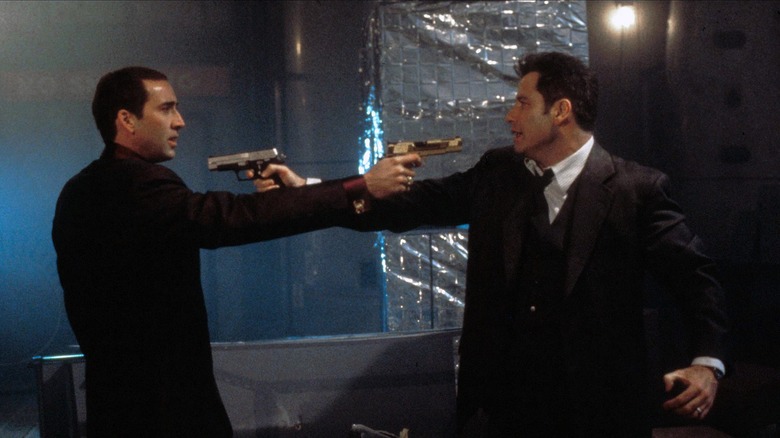
The origin of Nicolas Cage's rise to meme-fame extends further back than the 1997 schlocky cult classic "Face/Off," but I'd go so far to say that there might not be a more fitting representation of everything that the A-list actor brings to the table. The John Woo action film, starring Cage and John Travolta as the co-leads of one of the most ridiculous premises ever to grace American cinemas, rightfully stands tall in the pantheon of both Cage movies and body-swapping narratives.
In case anybody needs a refresher, the plot of "Face/Off" involves Cage's criminal mastermind Castor Troy undergoing a procedure to switch faces with the vengeance-seeking FBI agent hot on his tale, Travolta's Sean Archer. It's the kind of absurdity that, looking back with the wistfulness of hindsight, we'd have to acknowledge only movies of a certain time could truly get away with. That's why the rumors of a possible reimagining of the movie have always been met with equal parts incredulity and excitement among film fans ... until those rumors became closer to reality, that is. Initially billed as a remake and since clarified to be a direct sequel, the responsibility of pulling off the same lightning-in-a-bottle magic one more time has fallen to "The Guest" and "Godzilla vs. Kong" director Adam Wingard.
Never mind that a sequel with both stars potentially returning would seem to be somewhat difficult, given what happened at the end of the film. Maybe that's partly why Wingard is describing the script as "probably the most challenging script" he and writer Simon Barrett have ever worked on together.
Face ... On?
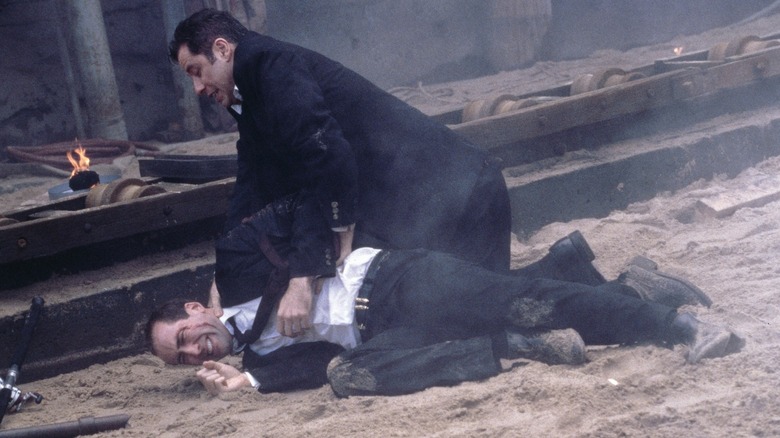
How can one ever hope to improve on perfection? Finding an answer to that impossible question is one of many reasons why I'm glad I'm not in show business, but Adam Wingard and his usual co-writer Simon Barrett have taken this challenge head (face?) on. In an interview with Empire, Wingard provided a quick update on where things stand with the in-development script for their "Face/Off" sequel.
"We're really honing in on it. We're not going to share it until everybody's like, 'This is the one.'
I think we really got it. It has been probably the most challenging script we've ever worked on, for a lot of reasons. There's so much pressure in wanting to make sure that it lives up to the legacy of that project. But every draft you have these things that just click in, and you're like, 'A-ha! That's really what 'Face/Off' is!'"
You have to admire the sheer amount of courage it takes to look at a movie like "Face/Off" and figure out a way to crack the code for a decades-later sequel that could ever live up to the zaniness of the original. Given the recent resurgence that Nicolas Cage has enjoyed on the heels of "Pig" and especially "The Unbearable Weight of Massive Talent," it was probably only a matter of time before Hollywood came knocking on Cage's door to brush the cobwebs off one of his most inane (but oddly entertaining) projects ever. Here's hoping Wingard and Barrett will somehow be able to spin some magic out of this idea one more time.
Read this next: Horror Roles That Changed Actors Forever
The post Face/Off 2 is 'The Most Challenging Script' Adam Wingard and Simon Barrett Have Ever Worked On appeared first on /Film.
50 Years of Text Games is now on Kickstarter
Don’t Make These Food Safety Mistakes at Your Summer Barbecue

Cookout season is finally upon us—but with all the fun of cooking and eating outdoors comes additional food safety concerns. You’ve probably eyed a creamy potato salad and intuitively known it’s probably not ideal for it to be sitting out in the sun all day—even though the truth about mayo may not be as scary as you…
'Rust Is Hard, Or: The Misery of Mainstream Programming'
Read more of this story at Slashdot.
Apple Will Allow Linux VMs To Run Intel Apps With Rosetta In macOS Ventura
Read more of this story at Slashdot.
Hubble Captures Record-Breaking 'Sneak Peek' of James Webb Space Telescope Discoveries - CNET
China 'Must Seize TSMC' If the US Were To Impose Sanctions, Says Top Economist
Read more of this story at Slashdot.
MacOS Will Soon Block Unknown USB-C Accessories By Default
Read more of this story at Slashdot.
The Boys' Erin Moriarty On The 'Amazing, Hilarious, And Scarring' Herogasm Episode [Exclusive]
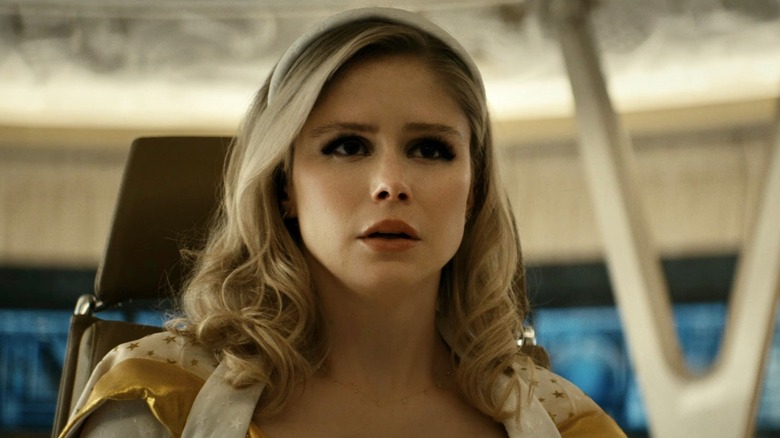
This article contains potential spoilers for current and future episodes of "The Boys" season 3.
Season 3 of "The Boys" and its shrinkable new superhero, Termite, have already given us their own disturbing explode-a-butt rendition of a certain Ant-Man and Thanos meme, but if you thought that was graphic, you ain't seen nothing yet. The upcoming sixth episode of "The Boys" season 3 will be adapting the controversial "Herogasm" storyline from the "Boys" comics by Garth Ennis and John McCrea, and let's just say it involves the Boys infiltrating a superhero orgy.
/Film's Rafael Motomayor recently conducted an interview with Erin Moriarty who plays Starlight, the newly minted co-captain of the Seven with Homelander (Anthony Starr) on "The Boys." A superhero team sponsored by Vought International, the Seven parodies Zach Snyder's "Justice League," with its abandoned tagline of "Unite the Seven." In its "Herogasm" episode, slated to be the sixth in the season, "The Boys" may be uniting heroes in a more biblical sense, as they have carnal knowledge of each other in said orgy.
Moriarty had this to say about filming the risqué episode:
"It was five days in a row, 12-plus hours a day, well over 12 hours, of just being surrounded by nudity. And it was pretty wild. I'd never been in a room with so many dildos, so many sex toys, so much nudity, so much simultaneous sex going on in all different ways. I had to do one scene with one character where I'm talking to him and he's totally nude. So I'm trying to maintain eye contact with him because that was on the first day and I'm still getting used to working around so many naked people."
'He All Of A Sudden Became A Porn Director'
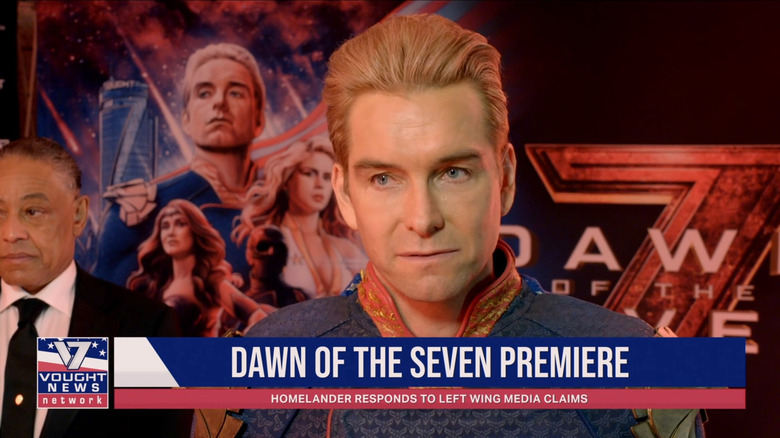
"The Boys" season 3 has done an expert job so far of skewering our superhero-obsessed culture, showing how its homicidal "heroes" engage in Nazi-potato-porn scenarios when they're not smiling at red carpet premieres or keeping up the corporate lie of Voughtland's Inclusive Kingdom. For Moriarty, however, one of the biggest highlights of shooting season 3 came from watching the director of the "Herogasm" episode choreograph an orgy scene as if he were a legit porn director (or maybe Stanley Kubrick blocking "Eyes Wide Shut"). She continued:
"I think my favorite part was observing the director of that episode, Nelson Cragg, who was so awesome, directing the people in the background who are simulating sex. He all of a sudden became a porn director. And the things that he was saying to them to get what he wanted for them to simulate sex, I think that was one of my favorite parts of filming the episode, is just observing him and then him yelling, 'Cut,' and shaking his head like, 'What am I doing?' But it was amazing, hilarious, and scarring at the same time."
The first three episodes of "The Boys" season 3 are currently streaming on Prime Video, with episode 4 set to air on June 10, 2022, and new episodes coming every Friday thereafter.
Read this next: 14 Remakes That Are Better Than The Original
The post The Boys' Erin Moriarty on The 'Amazing, Hilarious, and Scarring' Herogasm Episode [Exclusive] appeared first on /Film.
Apple Announces M2 SoC: Apple Silicon for Macs Updated For 2022
Though primarily a software-focused event, Apple’s WWDC keynotes are often stage for an interesting hardware announcement or two as well, and this year Apple did not disappoint. At the company’s biggest Mac-related keynote of the year, Apple unveiled the M2, their second-generation Apple Silicon SoC for the Mac (and iPad) platform. Touting modest performance gains over the original M1 SoC of around 18% for multithreaded CPU workloads and 35% in peak GPU workloads, the M2 is Apple’s first chance to iterate on their Mac SoC to incorporate updated technologies, as well as to refresh their lower-tier laptops in the face of recent updates from their competitors.
With the king of the M1 SoCs, M1 Ultra, not even 3 months behind them, Apple hasn’t wasted any time in preparing their second generation of Apple Silicon SoCs. To that end, the company has prepared what is the first (and undoubtedly not the last) of a new family of SoCs with the Apple Silicon M2. Designed to replace the M1 within Apple’s product lineup, the M2 SoC is being initially rolled out in refreshes of the 13-inch MacBook Pro, as well as the MacBook Air – which is getting a pretty hefty redesign of its own in the process.
The launch of the M2 also gives us our first real glimpse into how Apple is going to handle updates within the Apple Silicon ecosystem. With the iPhone family, Apple has kept to a yearly cadence for A-series SoC updates; conversely, the traditional PC ecosystem is on something closer to a 2-year cadence as of late. M2 seems to split this down the middle, coming about a year and a half after the M1 – though in terms of architecture it looks closer to a yearly A-series SoC update.
How What We Do In The Shadows Season 4 Brings Baby Colin Robinson To Life
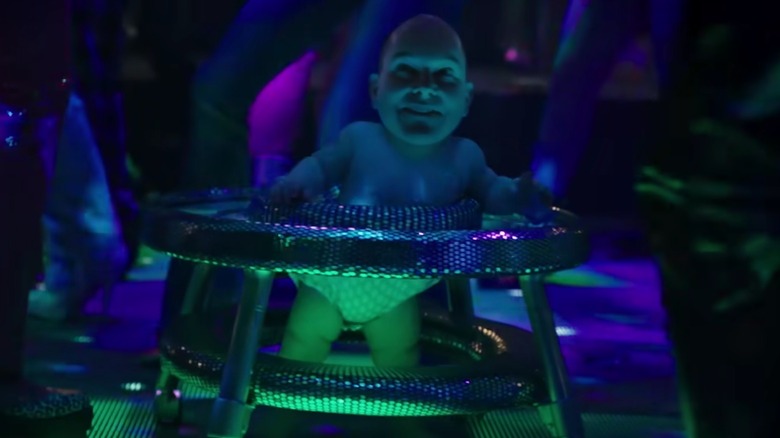
"What We Do in the Shadows" has had plenty of grotesque moments over the years, but few were as bizarre and squirm-inducing as the show's season 3 finale cliffhanger. After going to bed ill, obnoxious energy vampire Colin Robinson (Mark Proksch) dies in the night. It's apparently a natural thing, as energy vampires only live to be 100. Yet, as he mentioned earlier in the season, the lore around energy vamps seems pretty vague, so it came as no surprise when there was more to Colin's story. What is surprising? That he ended season 3 by being spontaneously reborn as a creepy, adult man-like baby.
In a press conference attended by /Film ahead of the show's fourth season, the team behind "What We Do in the Shadows" shared insight about the process of bringing baby Colin Robinson to unnerving, undead life. "The VFX team went above and beyond and really utilized every trick in the book that they could come up with to make it work," Proksch shared. "It was really complicated for them to figure it out to make it look as seamless as it does." The actor joked that it's "always a risk" when a show decides to turn a main character into a baby.
Energy Vampire Turned Energy-Sapping Toddler
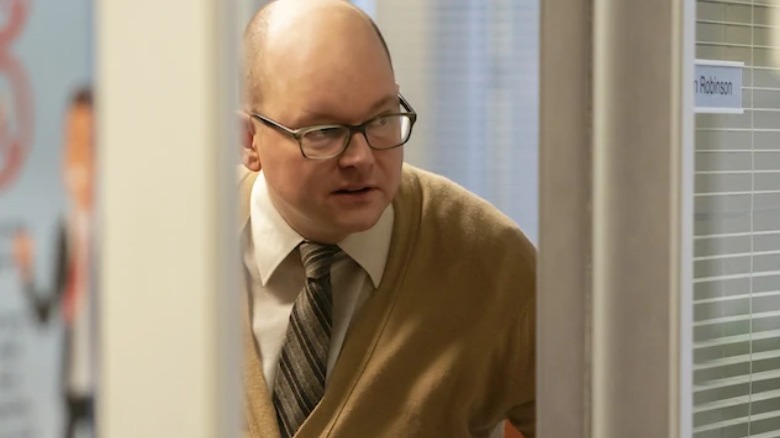
The team also revealed that, as an energy vampire, Colin seems to grow a little quicker than most kids, and a clip shared with those in attendance showed the character looking like a weird mix between a toddler and an adult man. A teaser for the season, which shows Colin partying in the club in a walker toy alongside his vampire roommates, seems to include a baby-like body with what looks like a small version of adult Colin's head on it. It's all extremely weird-looking, but that seems to be by design as the character's power has always come from being the most off-putting guy around.
Executive producer and writer Paul Simms explained that the monstrosity that is baby Colin isn't purely CGI. Instead, a mixture of practical effects, VFX, and on-set elements made the little stinker look as real as possible. "We never found a way that would work for every shot," Simms admitted, "so it was an improvisation technically the whole way." Here's more from Simms on the process:
"Sometimes it's practical effects, sometimes it's visual effects, digital effects. Sometimes it's camera angles, sometimes it's wigs. We used every trick under the book which is what you have to do when you plan a big story without knowing how you're going to do it beforehand."
Colin may look different now, but it sounds like he's still a hilarious drain on the energy of everyone around him. Simms explains that the baby sucks up everyone's energy, but it's hard to tell whether that means he's more powerful than ever, or just like any other two or three-year-old.
"What We Do in the Shadows" returns to FX on July 12, 2022.
Read this next: The 11 Best Star Wars Droids Ranked By Usefulness
The post How What We Do in the Shadows Season 4 Brings Baby Colin Robinson to Life appeared first on /Film.
A Look At The Munsters Has Sheri Moon Zombie's Lily Supporting A Local Small Business
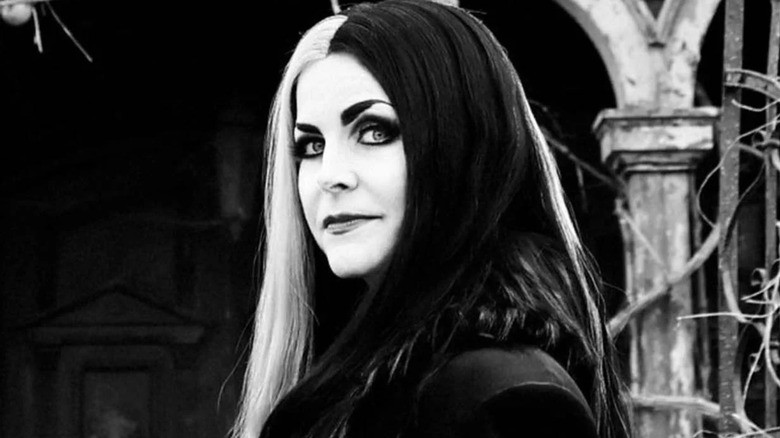
Gather around, monster kids, because we've got more news regarding Rob Zombie's cinematic version of "The Munsters." Continuing his trend of releasing exclusive behind-the-scenes photos and announcements from set through his personal Instagram account, Rob Zombie has revealed the best photo yet of Sheri Moon Zombie as Lily Munster, supporting some little entrepreneurs from Mockingbird Heights. The full-color photo shows Sheri Moon's Lily Munster paying for a drink at a lemonade stand that's popped up in front of 1313 Mockingbird Lane, the iconic castle home of The Munster family.
"Lily always supports the local businesses of Mockingbird Lane," captioned Rob Zombie. "The adults may be scared, but the kids understand." Adults have easily been the ones most concerned with how "The Munsters" is going to turn out, but fears have mostly subsided thanks to the reveal that the film was going to be rated PG, thereby squashing any fears that Marilyn Munster was going to wear KISS t-shirts and drop expletives between every other word a la Laurie Strode in Zombie's "Halloween II."
Zombie ended the photo caption with an all-caps declaration of "BIG NEWS COMING THIS WEEK!" It seems likely that the week's big news may be the definitive release date of "The Munsters" coming this Halloween season, but there have been rumors swirling for the last month about the possibility of the film leaving Peacock and arriving, instead, on Netflix. With Netflix Geeked Week happening right now, it's hard not to throw on a tin foil hat and believe the rumors.
A Closer Look At Lily Munster
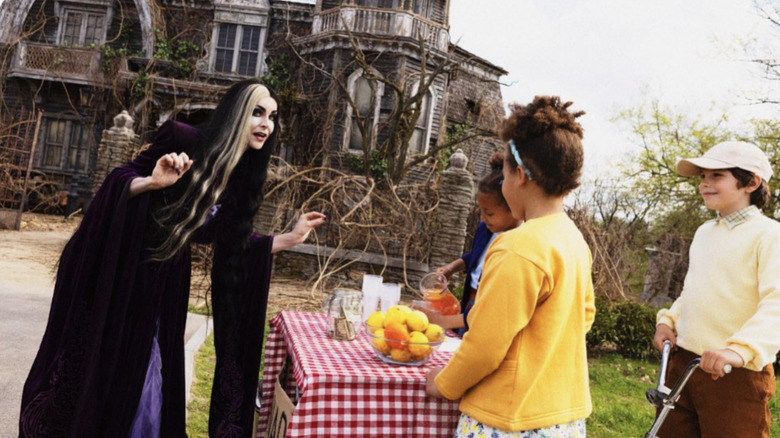
Sheri Moon's look as Lily Munster honors the original hair, makeup, and dress design made famous by Yvonne De Carlo, but looks to have traded out the blue/green tint for a pale white vampy complexion. Last week, Zombie again took to Instagram to show Uncle Gilbert (the Gil Man) had wrapped shooting on the film, which included a dancing Sheri Moon Zombie and Jeff Daniel Phillips as Lily and Herman Munster, respectively. The video provided a fantastic look at the cloak worn by Sheri Moon, but with Rob Zombie including a distressed filter over the footage, it was difficult to confirm Lily's makeup.
Thanks to this new photo, we can for sure confirm that Lily's makeup is a contrasting pale white with dark features, with the memorable eyebrows and "Bride of Frankenstein" style white streak on full display. The children's clothing gives the impression of a throwback appearance, but considering contemporary fashion frequently brings back vintage looks, the film could very well take place in the present day. Jeff Daniel Phillips even commented on the photo saying, "She really does have the sweetest cold heart on the block," indicating that Lily Munster will be as kind-hearted and lovely in the film as she was in the original television series.
Read this next: 20 Underrated Rom Coms You Need To Watch
The post A Look At The Munsters Has Sheri Moon Zombie's Lily Supporting A Local Small Business appeared first on /Film.
The danger lurking under 12 military bases is........... the US Air Force [Followup]
Scratching That Itch: Can Androids Pray: Red
This is the one hundred twenty-fifth entry in the Scratching That Itch series, wherein I randomly select and write about one of the 1741 games and game-related things included in the itch.io Bundle for Racial Justice and Equality. The Bundle raised $8,149,829.66 split evenly between the NAACP Legal Defense and Education Fund and Community Bail Fund, but don’t worry if you missed it. There are plenty of ways you can help support the vital cause of racial justice; try here for a start. Lastly, as always, you may click on images to view larger versions.
Our next random selection from the itch.io Bundle for Racial Justice and Equality is facing its own mortality. It’s Can Androids Pray: Red, by Natalie Clayton, and its tagline in the bundle reads:
Angry femme mech pilots at the end of the world.
That’s actually a very informative tagline.
Can Androids Pray: Red is a visual novel. The “Red” refers to the fact that there are two version of it, one with red colors and one with blue colors. I believe they are otherwise identical. Only the Red version is included in the bundle. While Natalie Clayton is listed as the developer, Can Androids Pray features writing from Xalavier Nelson Jr. and music from Priscilla Snow (AKA Ghoulnoise). These are all names familiar to me for their work in the indie games scene. Natalie Clayton writes about games for a living, but also develops some; Xalavier Nelson Jr. has been involved with a ton of indie titles, most recently Space Warlord Organ Trading Simulator and An Airport For Aliens Currently Run By Dogs; and Priscilla Snow has scored numerous indie games including Voyageur, A Good Snowman Is Hard To Build, and Patrick’s Parabox. A strong lineup.
I love the presentation in Can Androids Pray. Rather than the typical 2D art seen in most visual novels, we have a low-poly 3D scene here, of two heavily damaged mechs lying in a desolate canyon. The camera is mobile, sometimes panning or swooping through the scene, other times showing us the slightly swaying view from one of the cockpits (or an aerial drone cam), complete with a HUD overlay full of damage warnings. The two pilots are going to die, when the sun comes up. Their mechs are too damaged to move, the atmosphere outside is toxic, and one of the mechs has a cut fuel line which will trigger an explosion once the heat from the sun arrives. As they talk to each other during their last moments, the light changes, shifting from darkness into dawn. It looks fantastic, and is elevated by Prscilla Snow’s evocative score, with certain parts of the conversation timed to dramatic changes in the music. All of this makes for a slick experience that is great at setting an appropriate mood.
Can Androids Pray is pretty short, around 10-20 minutes to play through. Mostly it involves listening to the talkative Beatrice, while players (as the more taciturn Cortney) occasionally pick responses. After a bit of anger and despair at their situation, Beatrice gets to the meat of the existential crisis when she starts talking about God. The Christian God, specifically, although much of the ideas are compatible with other religions too. This discussion, unfortunately, didn’t resonate with me, although I suspect it may connect with other players more deeply. Beatrice’s musings are based on the assumption of the existence of God, as some being beyond our understanding who created the universe and may or may not care about us. As someone who does not believe in the existence of God (or at least, not in the way God is discussed here), everything that followed felt meaningless. And even if God does exist, what is the point of such pondering when the answer can never be known?
I was amused to find that while Cortney can choose to engage in the philosophical discussion, she can also insist that it is pointless, or simply respond with rude insults. But I don’t think the latter two options change the narrative much, and while those choices felt more honest to my own viewpoint, I also worried that I would lock myself out of the very conversation the game is about. Having said that, I was more intrigued by some of the ideas brought up later in the game, and thought the ending was quite good. I also really liked the little hints about the world these pilots live in. They are clearly both soldiers, apparently for something called the Venutian Confederacy, but a few scant lines were the only hints I got as to what the Venutian Confederacy is about. The same is true for the enemy, the Mercury Protectorate. Can Androids Pray doesn’t really need these little tidbits about its world, but I love when games present themselves as a small part of a larger universe, their events not all that important in the grand scheme of things. Much the way Beatrice feels in relation to God, as she faces death.
This is one that will vary a lot for different players. If the central discussion of God is something that connects with you, you may love Can Androids Pray. If not, then the story may fall a bit flat, but it’s still told through a game that looks and sounds really cool, and doesn’t overstay its welcome. If any of that sounds interesting, definitely give Can Androids Pray a look (although check the content warnings on the itch.io page first). If you missed it in the bundle, it’s sold for a minimum price of $6.99, although it’s better to grab the package that costs the same but also includes the Blue variant and the option to pay a little extra for the soundtrack.
That’s 125 down, and only 1616 to go!



















